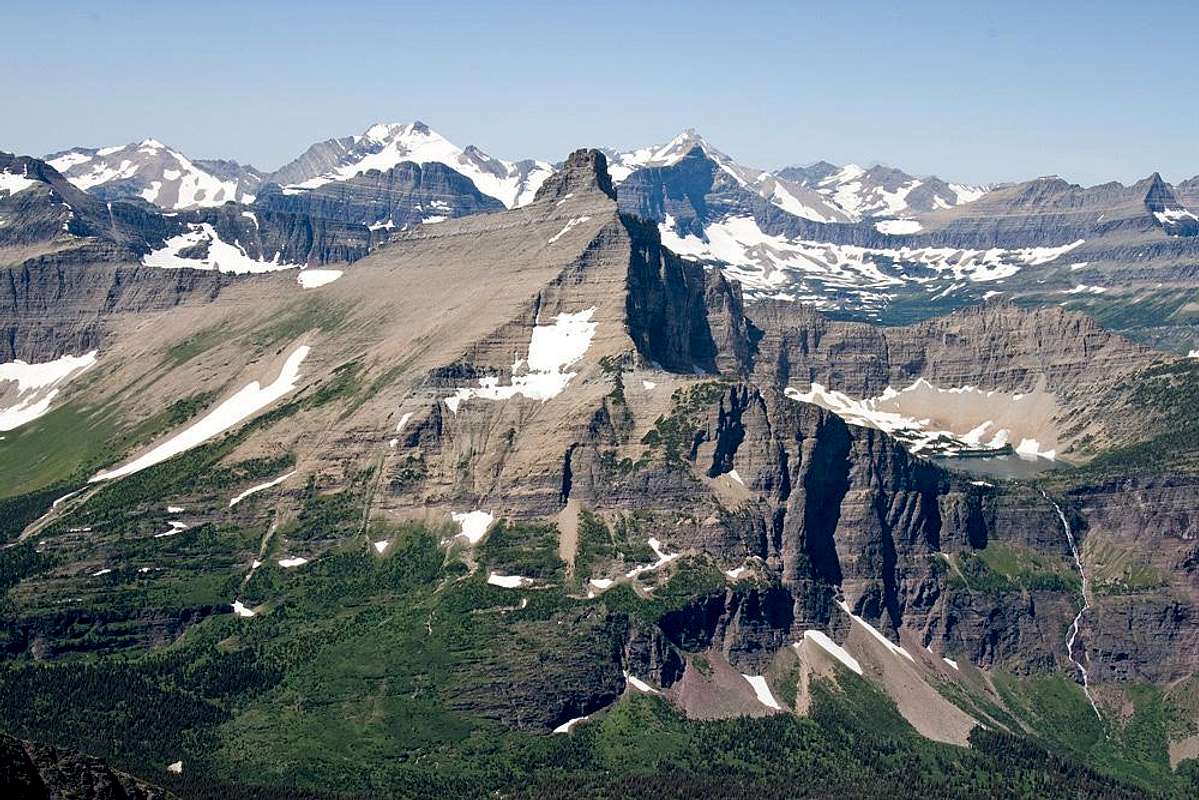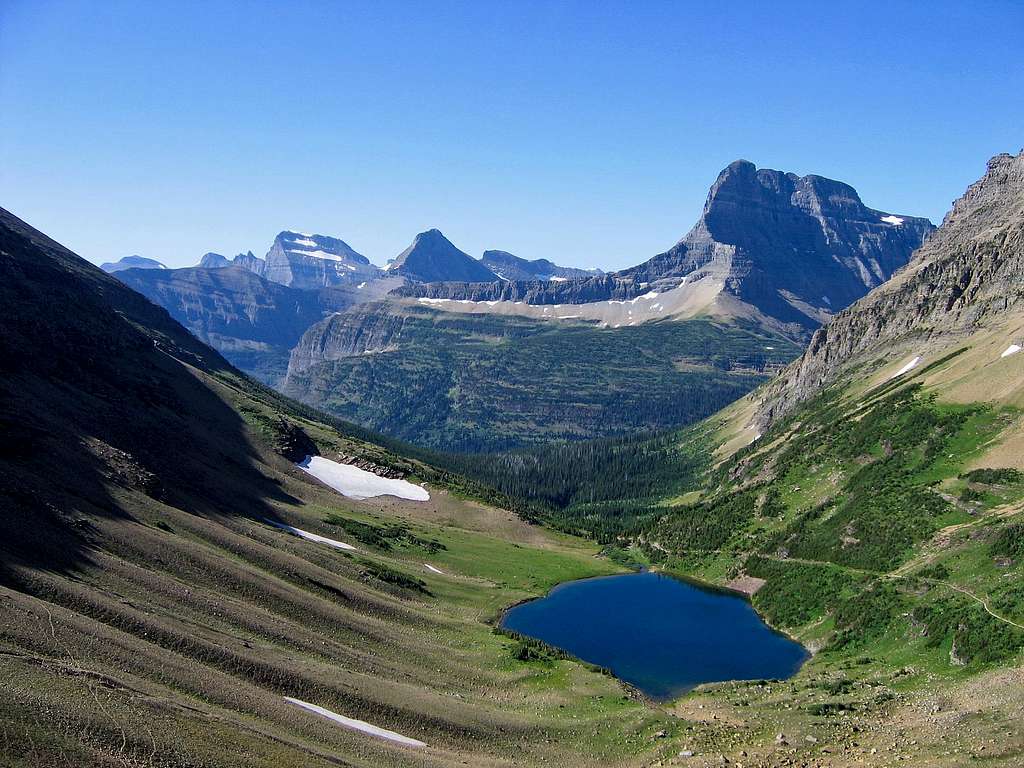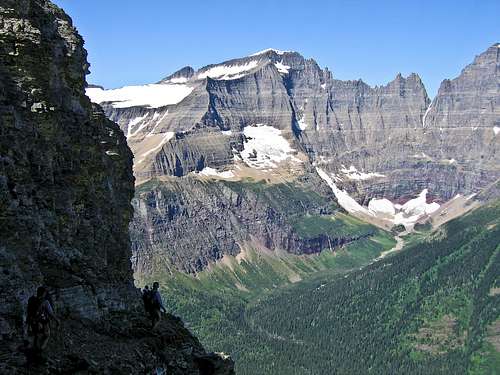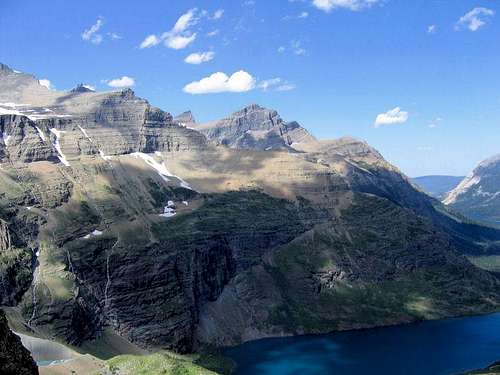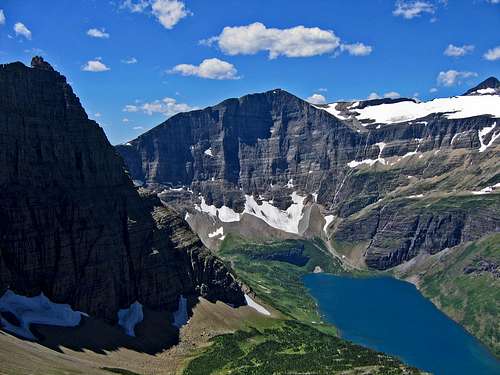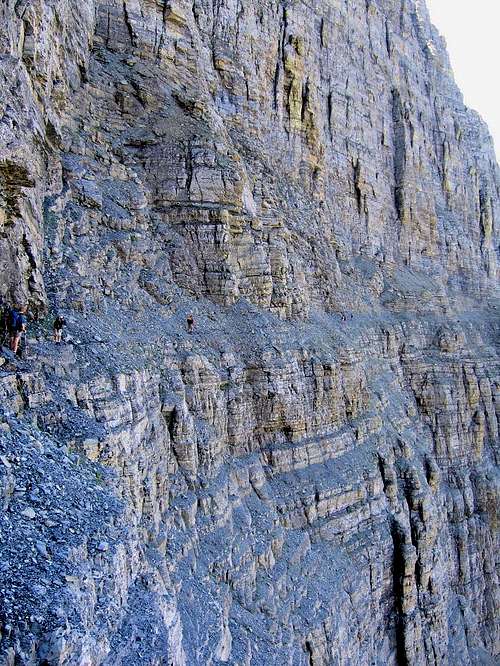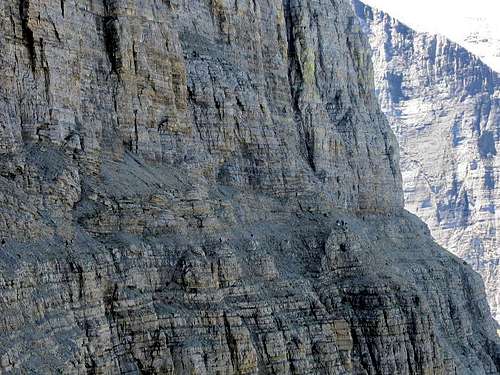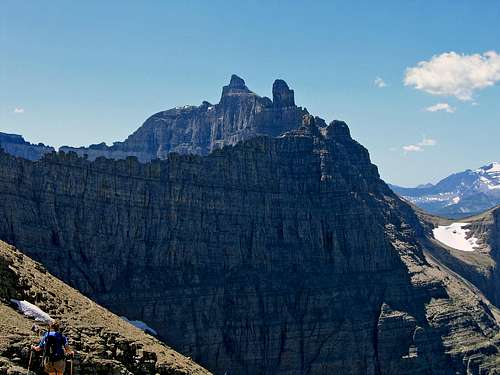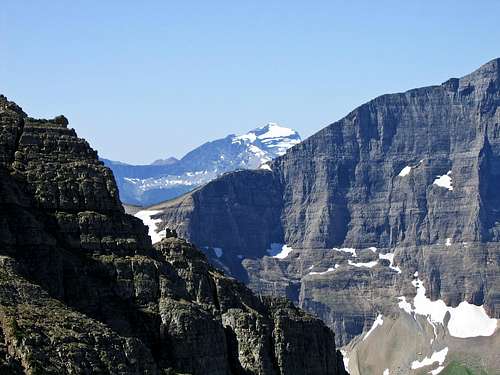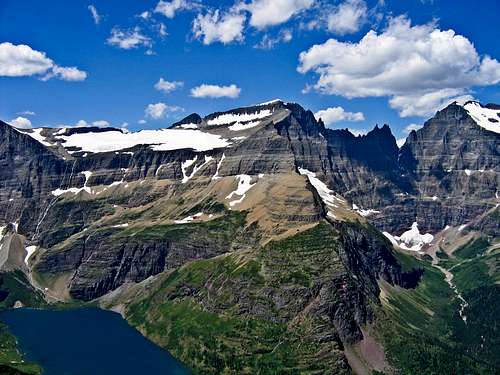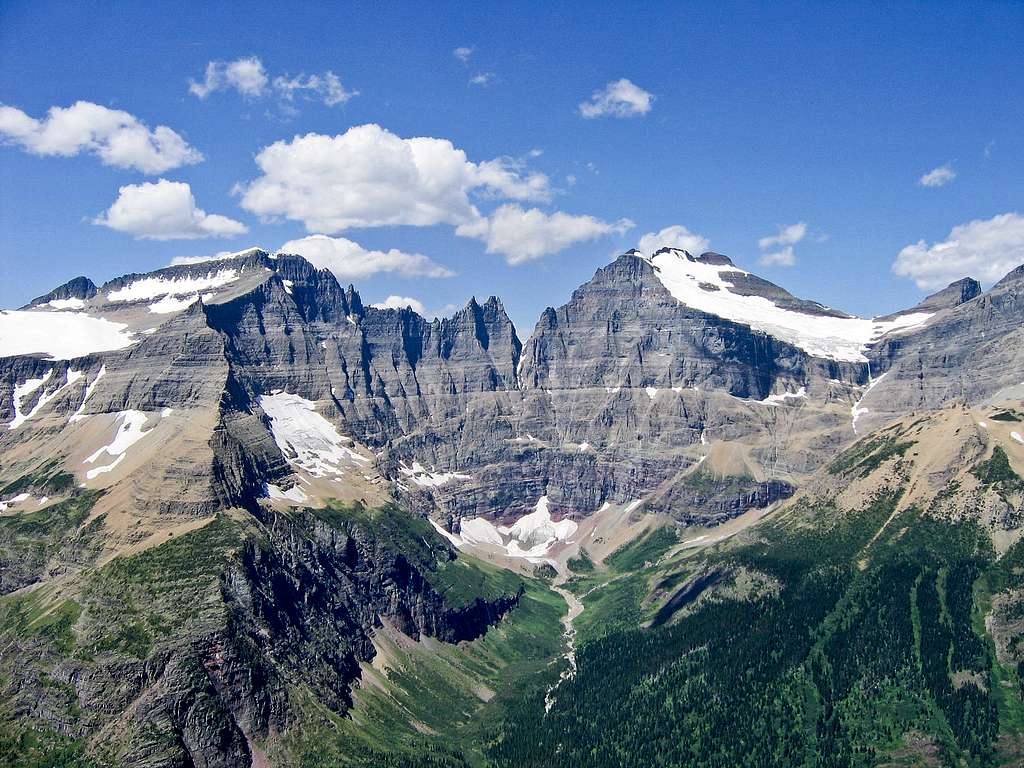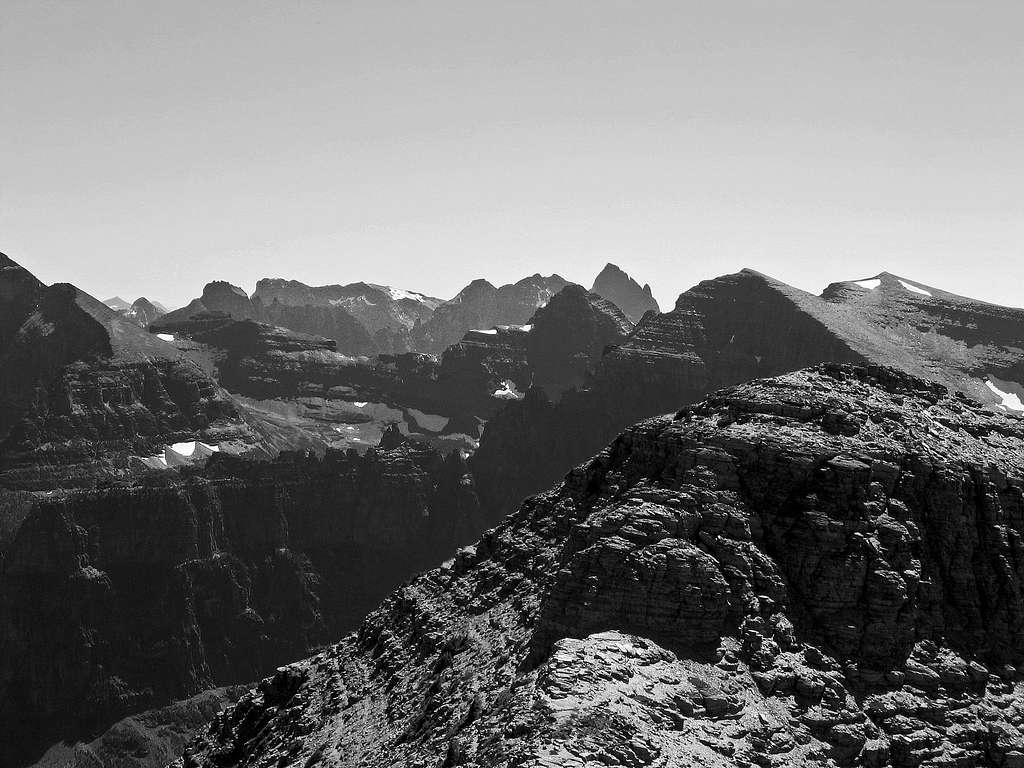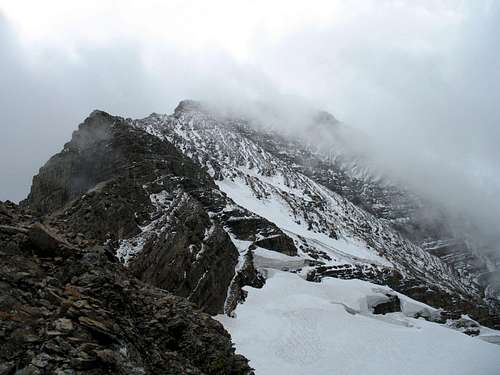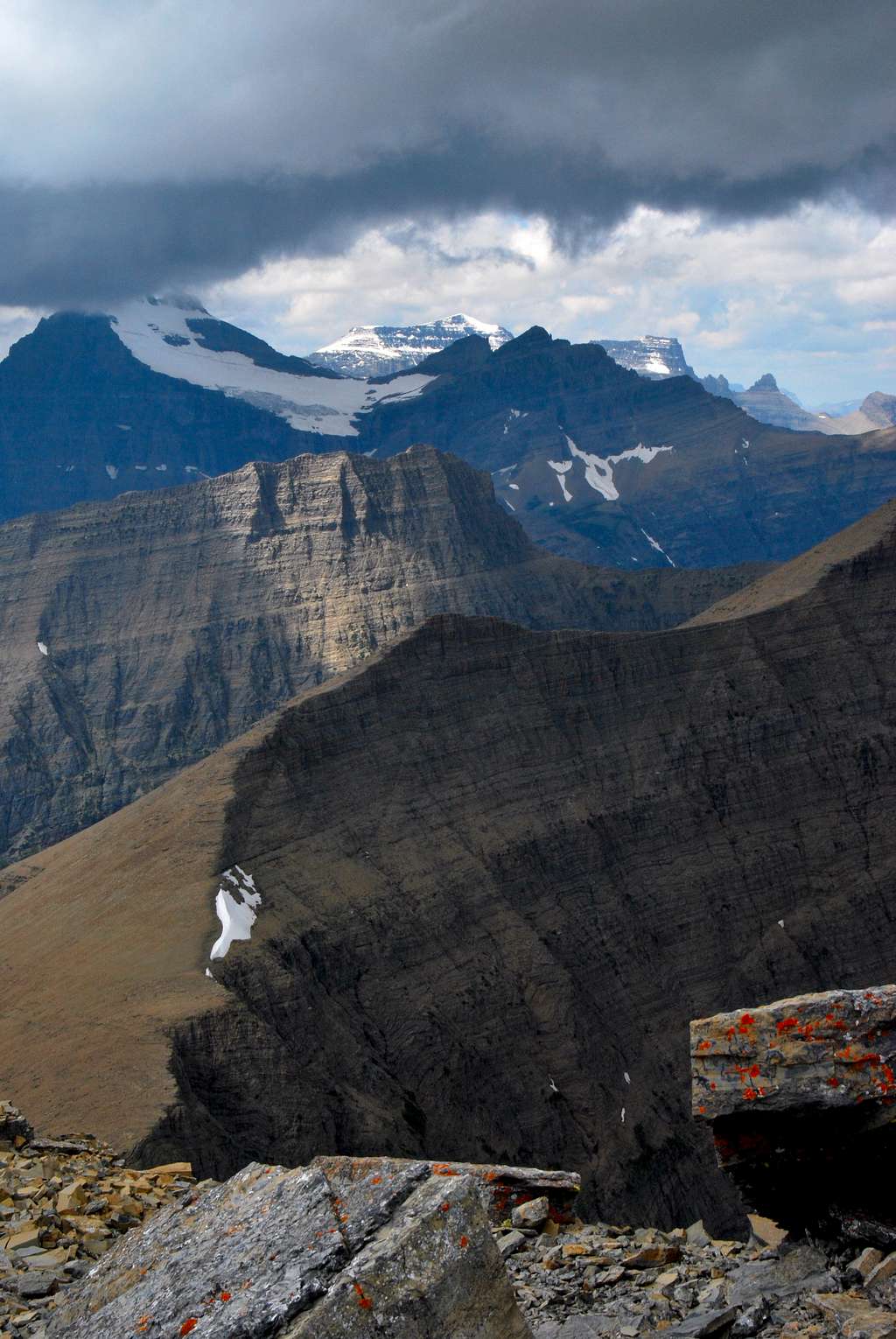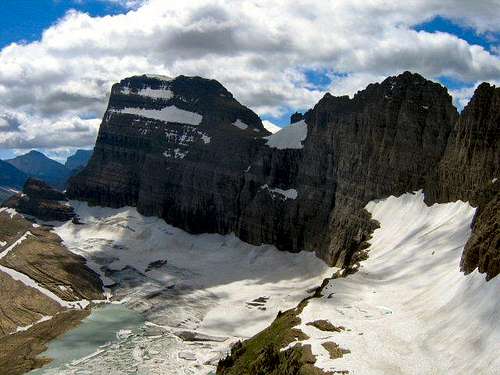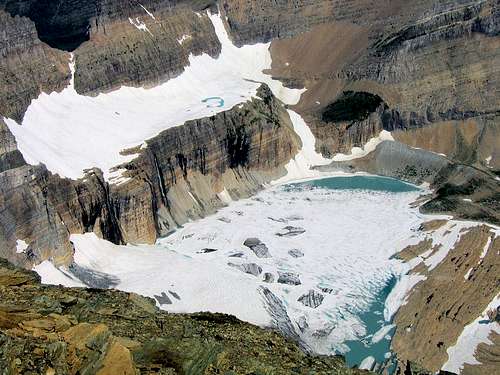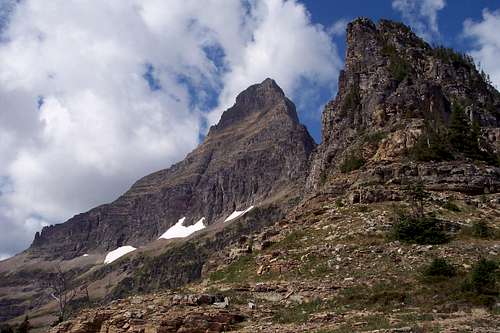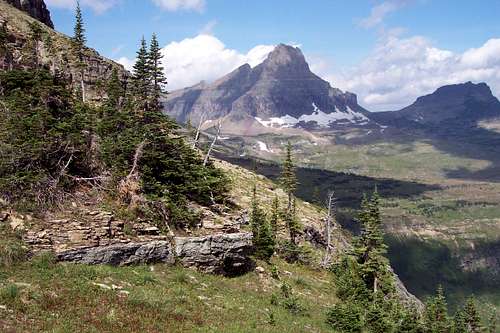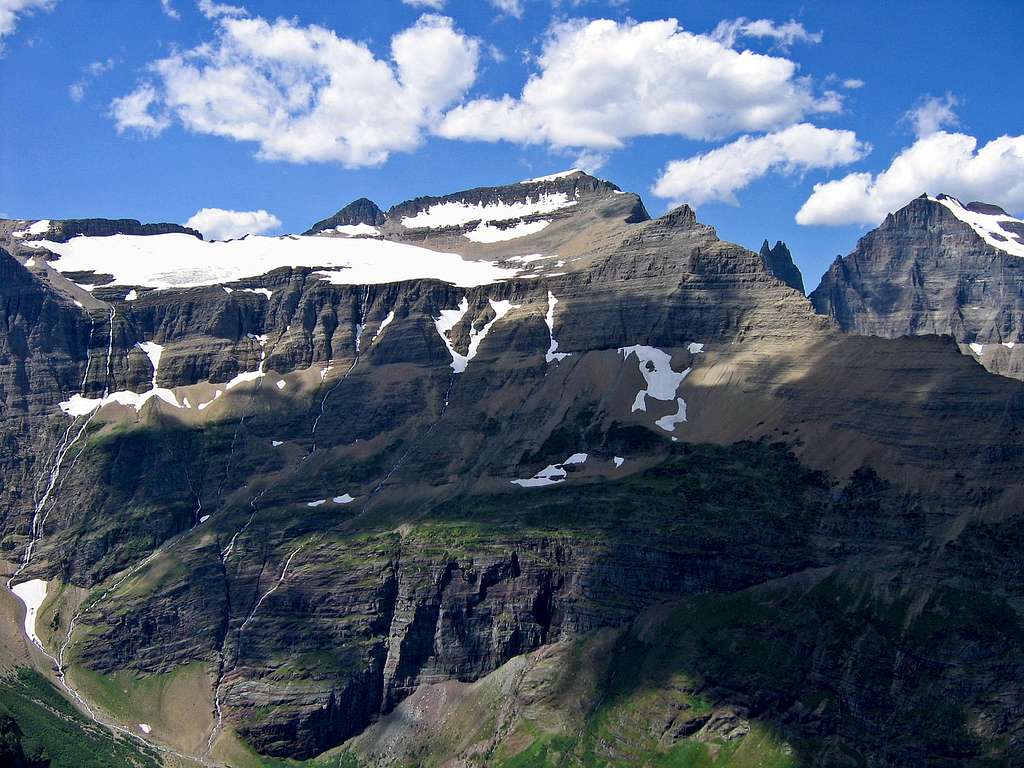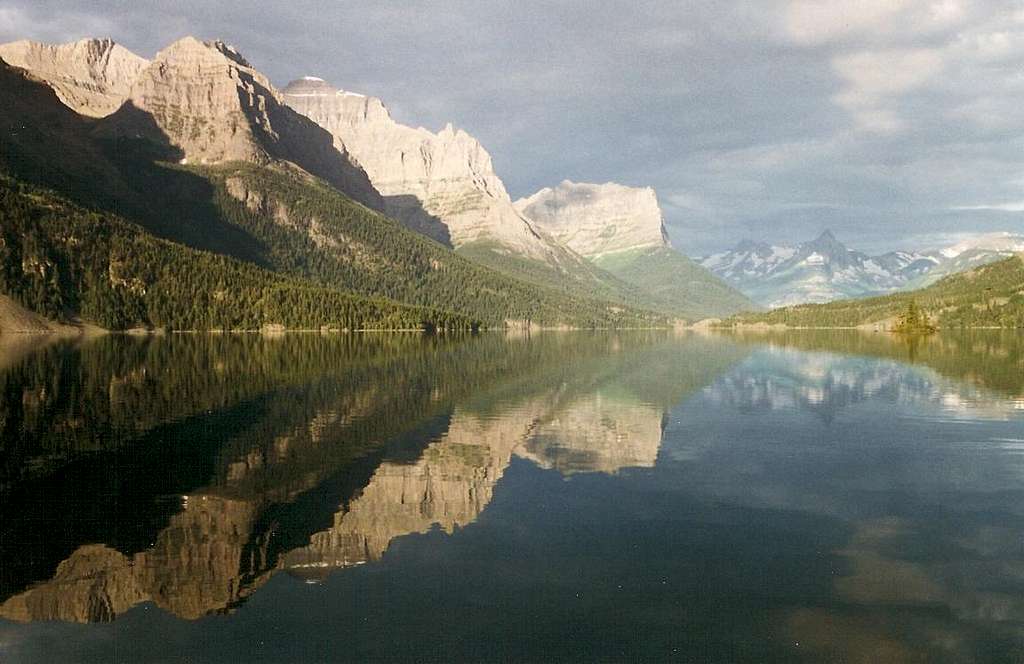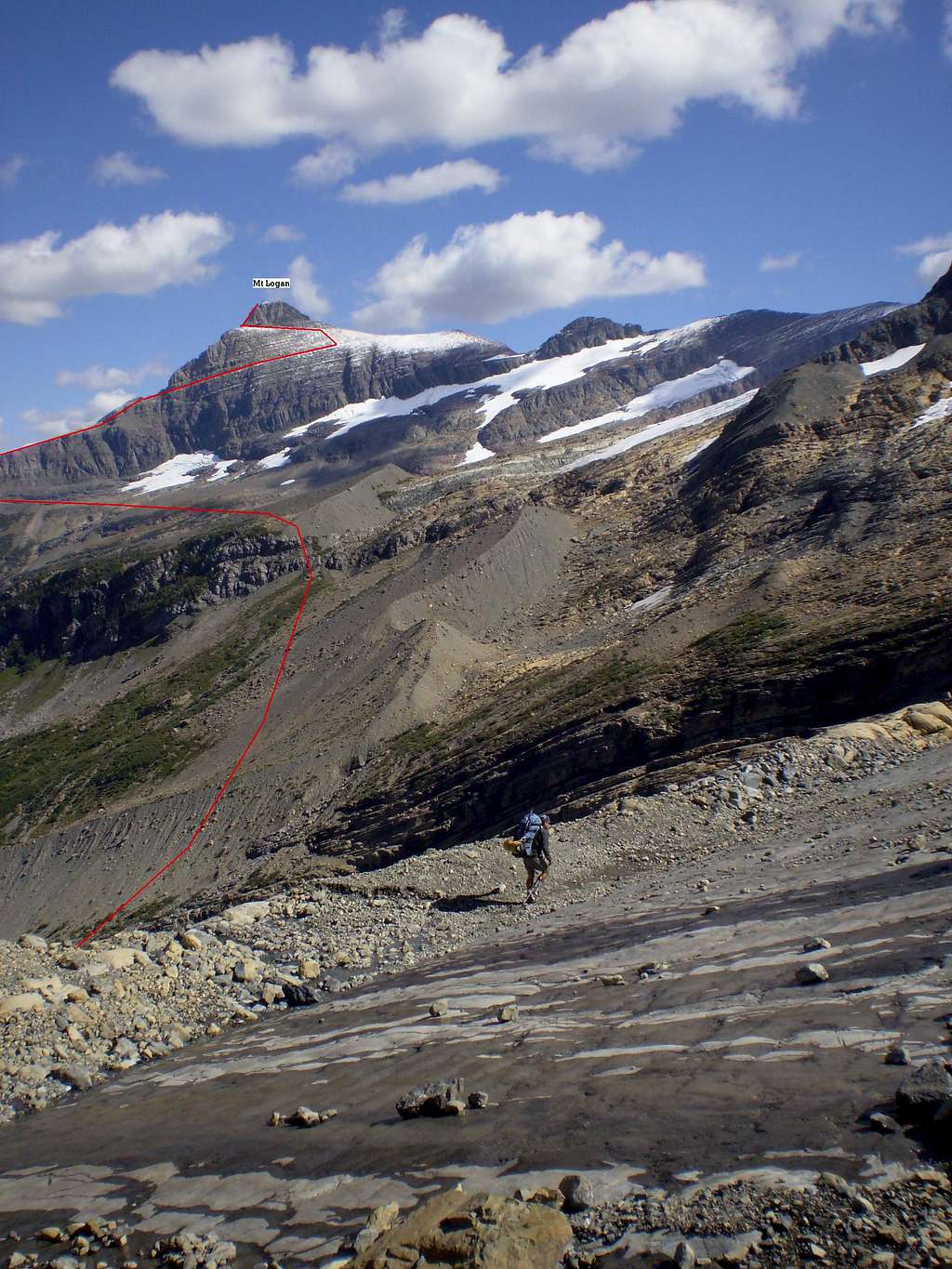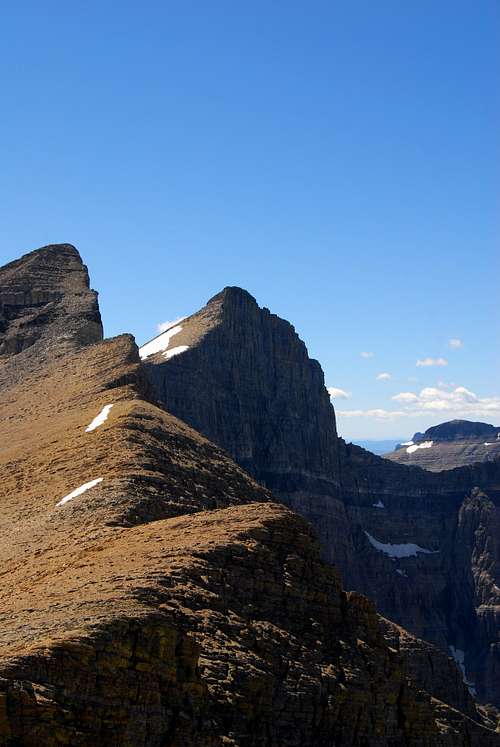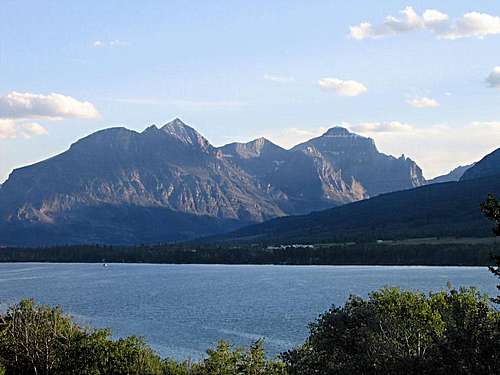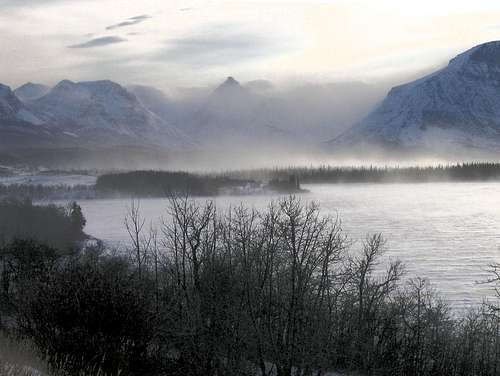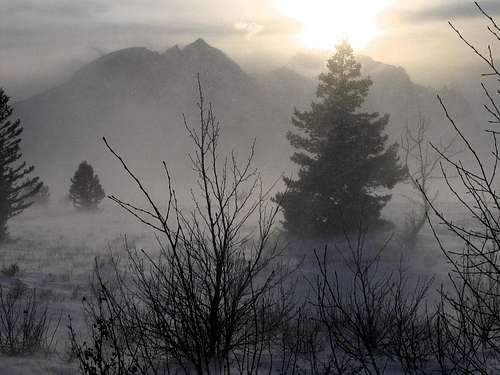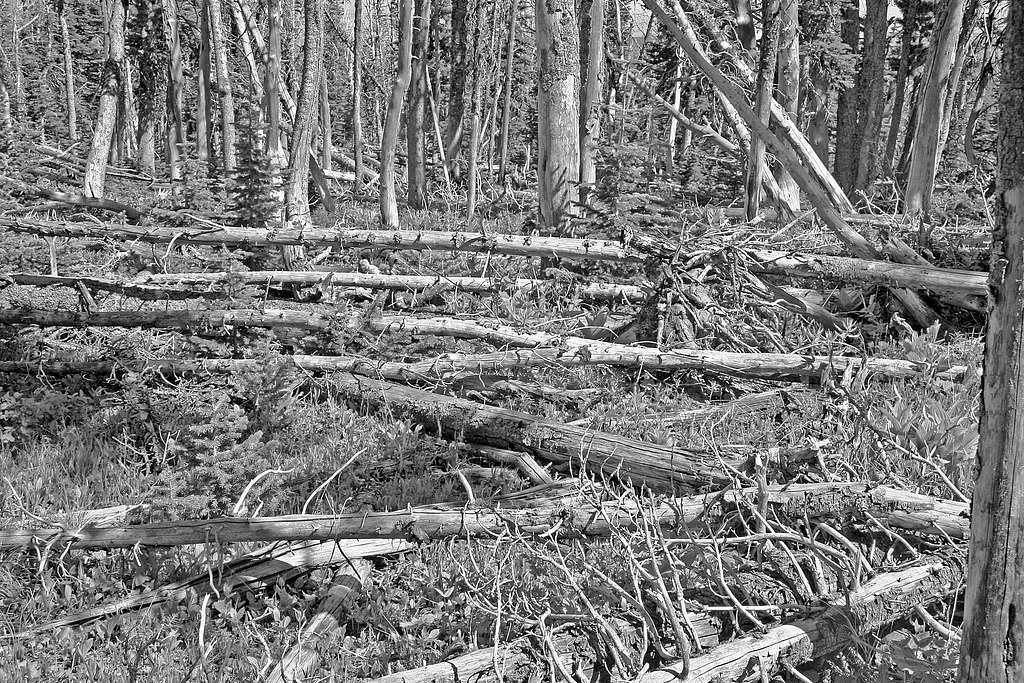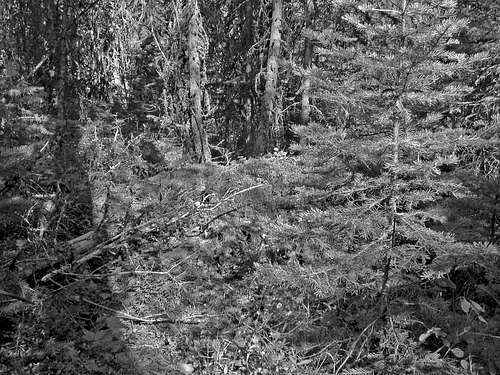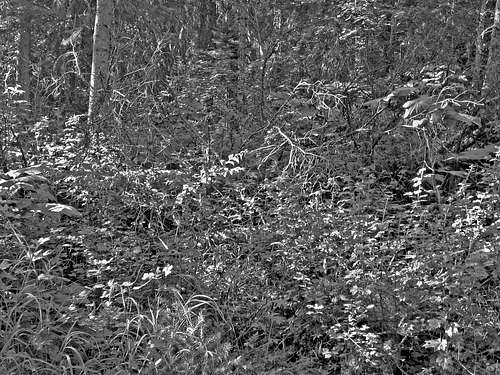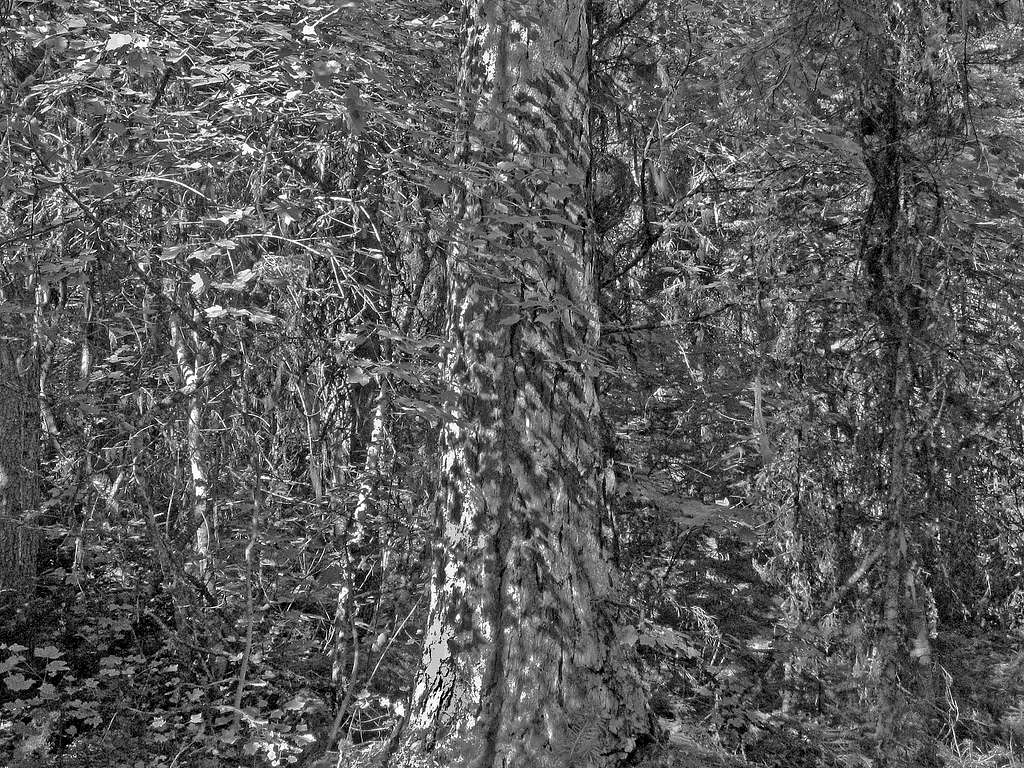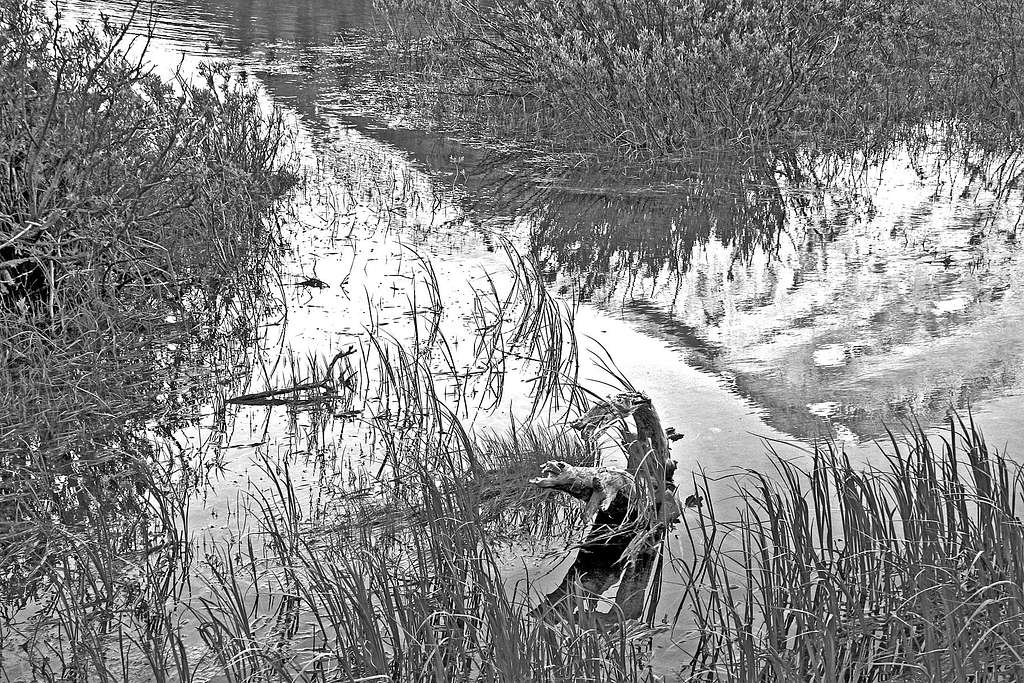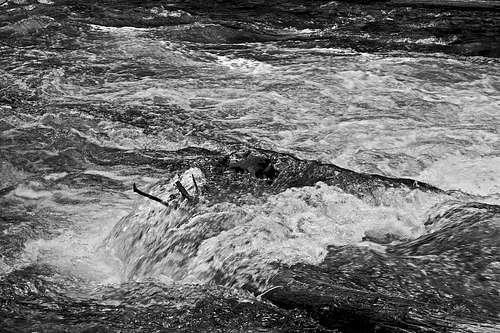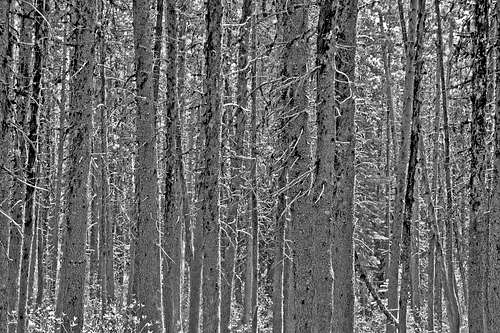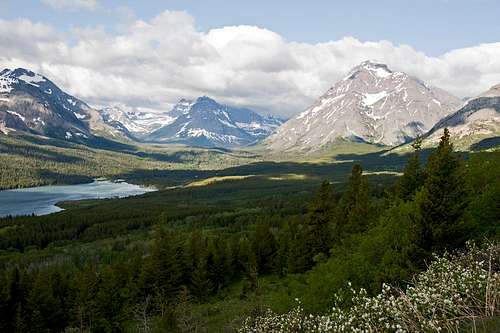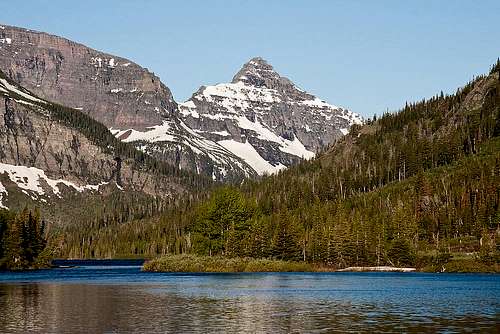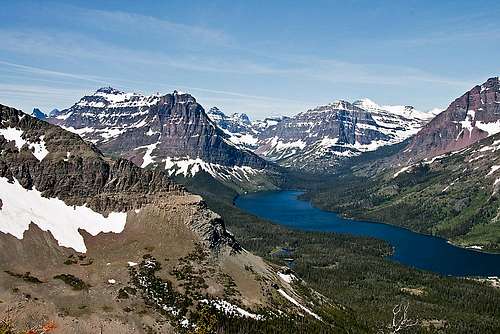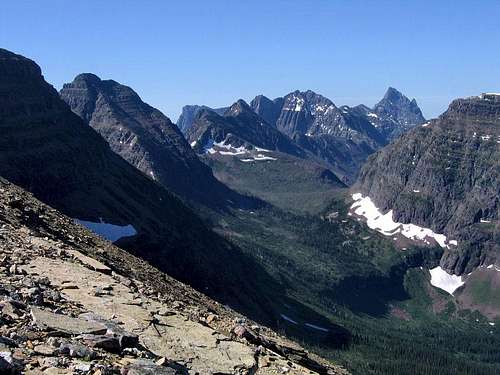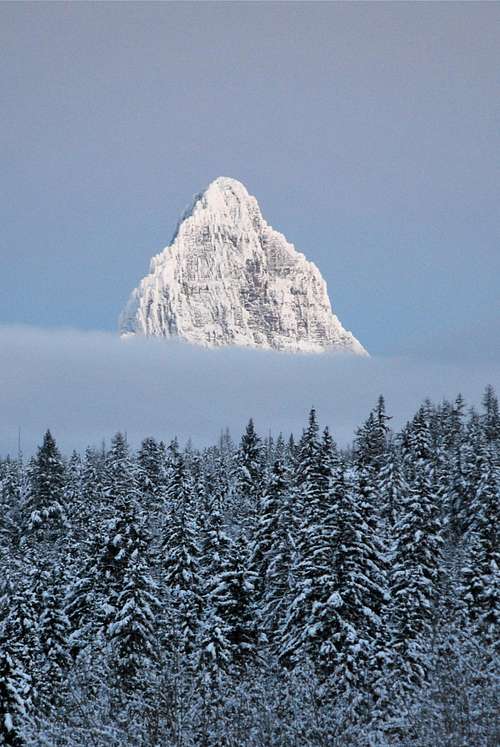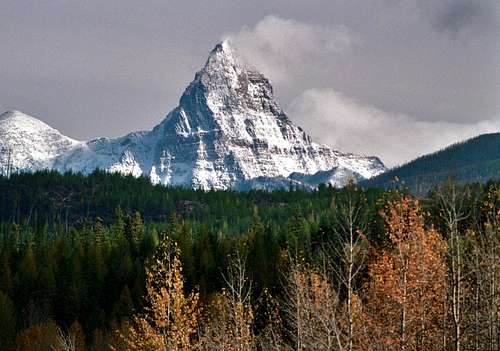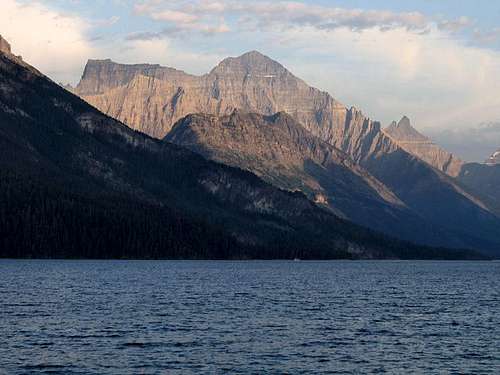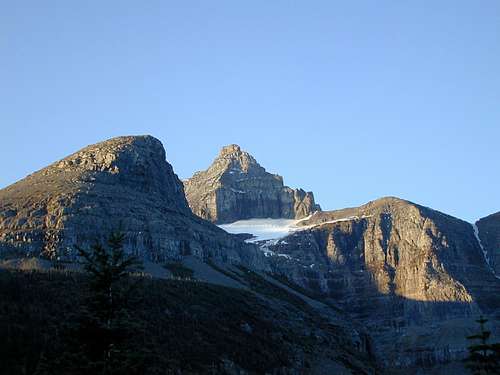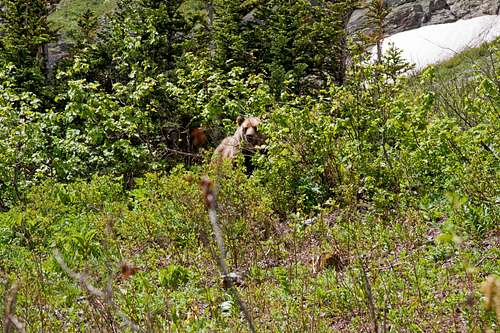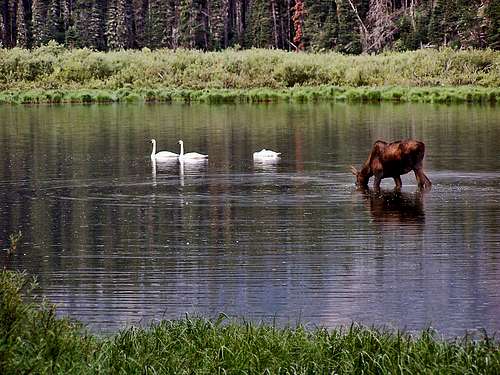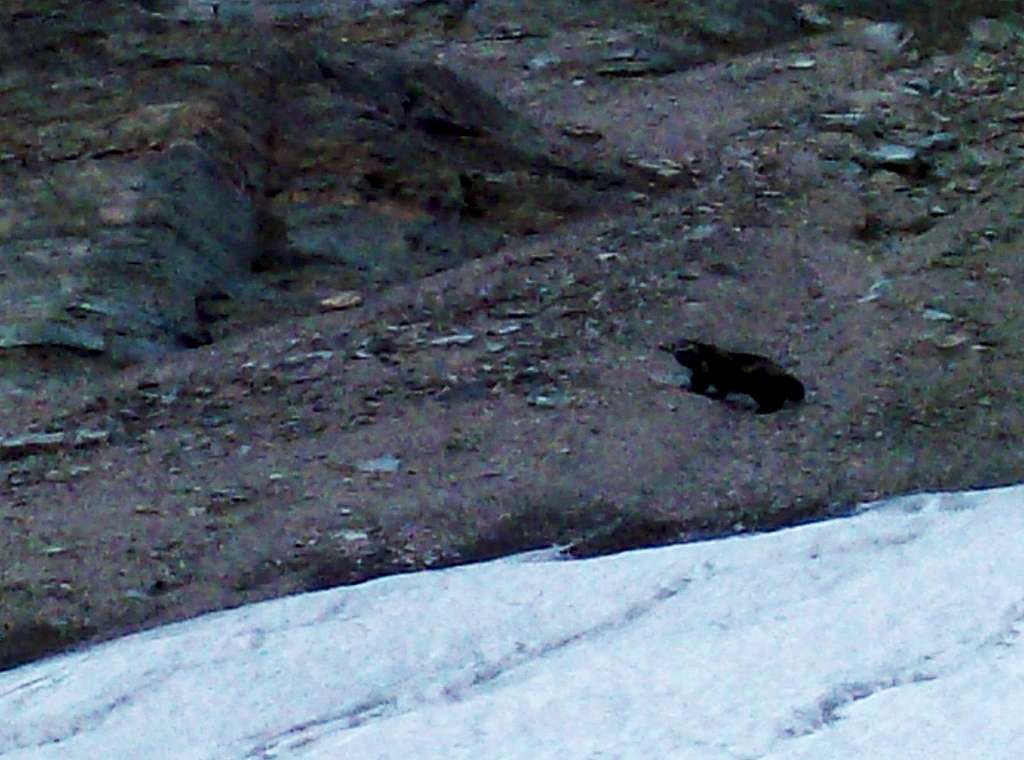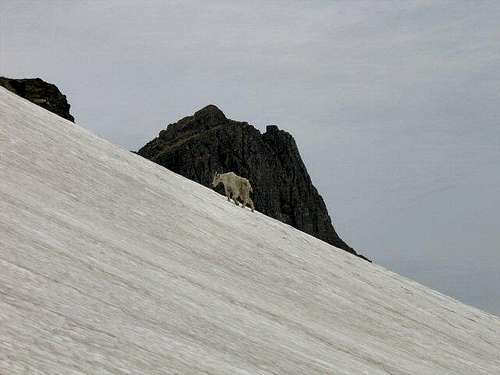-
 219294 Hits
219294 Hits
-
 100% Score
100% Score
-
 255 Votes
255 Votes
|
|
Area/Range |
|---|---|
|
|
48.69700°N / 113.717°W |
|
|
Hiking, Mountaineering, Trad Climbing, Scrambling |
|
|
Spring, Summer, Fall |
|
|
10466 ft / 3190 m |
|
|
Completed...but not to be set in stone.
This page now contains all the different areas of GNP, plus a variety of informational sections—in other words, all the parts are in place—yet it is still ongoing. It is not finished ("finished," as though nothing remains to add, or change), and I never expect to think of it as such, simply because each year's climbing brings with it the addition of a substantial amount of new visual material to incorporate, plus new experiences and information, and, hopefully, the same from others in the SP Community. Glacier National Park certainly doesn't exist as an unknown, and as long as I, and others, keep finding the place endlessly fascinating and wonderful, there will be no shortage of input from which to draw. To put it another way: It is an open-ended work.
So enjoy what's here, but do keep checking back; it is an organic, fluid proposition, with much to add, subtract, and rethink. I welcome your comments and suggestions. Also your photos. Enjoy this fantastically great place with me!
—Vernon
AND NOW....
TO BEGIN...CAREFULLY
(The Ptarmigan Tunnel to Ahern Pass Goat Trail)
Image taken while standing in front of the Ptarmigan Tunnel, looking back along the access trail from Many Glacier's Swiftcurrent Campground. Relax, enjoy the view, but don't dawdle for long: awaiting is an unforgettable excursion through the definition of what a mountain paradise is all about...
you get there by going this way...
[although do take the time to check out Bob Sihler's excellent
Ptarmigan Tunnel to Ahern Pass route page
—detailed information and some (very) nice pictures take
you through the heart of a truly unforgettable area!]
A marvel of goat engineering. That is what this page begins with.
There are a few things to remember, four of which come immediately, easily, to mind: Merritt. Ipasha. Natoas and Ahern, the bookends. Over and over they come at you, from that first unforgettable view when, by the simple act of walking around a cliff, with no warning you come face to face with thousands and thousands of vertical feet of glacially chisled rock looming impossibly big across the canyon, and no matter how many mountains you've already seen, it is special, and you know it's Merritt, with Old Sun Glacier drawing your eyes again and again to the summit, then sliding along the sharp-spired ridge to neighboring Ipasha—to a mountain as beautiful as its name. The glaciers had a field day here, munching and carving and ripping and making Paradise, and you do what everyone does: stop in your tracks and try fitting the vision in your head, until those behind let you know they'd like to see as well so would you please move on. Then, soon you hear the ones behind them, "hey, move along."
This goat trail has its dangers with exposure, and one soon learns to not walk and gape at the same time. The actual cliff part of this trek is about four miles long, and even though there is relief along the way, for maybe half that distance slipping on a pebble could prove...well, it's not something you want to do. You need to know how you react to exposure before these miles of greatness. In addition to the magnificent cliffs above and below this seemingly fragile marvel of goat engineering, across the way—always, The Four lying across the way!—is the Lithoid Cusp, the highest of a series of sharp, none-of-which-have-ever-been-climbed, spires forming the ridge between Merritt and Ipasha; and, at one point—not over there, but over here—the cliffs bend, wrap in a bit of a curve to reveal an unusual view of Iceberg Peak; then finally, coming towards Ahern Pass, the view opens to reveal another, more distant, beauty: seldom-climbed Longfellow Peak.
From Ahern Pass (and early in the summer you'll want both ice axe and crampons to ascend the snow field to the saddle—later in the summer you'll probably still want crampons; we did it late in July of a dry year, and were glad to have them) the ascent is 600' up to Iceberg Notch, which gives a rather precipituous view of the almost 1600' vertical climb down the other side to Iceberg Lake. I remember rather innocently asking, "where's the way down?" (I mean, for crying out loud, standing on the notch and peering down at the lake, you couldn't even see the way; it was too steep!) The answer, all the while gesturing down ("down" seems to be a key word here) to the lake, "that way." Very funny. But no ropes needed in good weather (actually, we didn't take ropes with us, because
Where to begin?
With something stunning, something getting-in-your-head memorable, that won't for any reason leave.
Not that you want it to....
Journey to "The Crown of the Continent"
Recent evidence shows there have been humans in this area dating as far back as 10,000 years, but it is not known for certain whether those original inhabitants were the distant forerunners of the tribes inhabiting the area today, or whether the present-day tribal ancestors arrived at a later date. By any reckoning, however, when the first Europeans came through—the British explorer David Thompson is credited as the first European to leave a recorded impression of the area, that in the 1780's—there had been people living on this land for a very long time.
The Blackfeet people living on the plains just east of the mountains called this area, "The Backbone of the World," and were the dominant tribe of the region long before the first explorers and fur trappers came onto the scene. Other tribes in the area were the Kalispel and Kootenai to the west; the Crow, Sioux, and Assiniboine in the south; and the Blood Indians to the north, in what is now eastern Alberta. The tribes, naturally enough, didn't have clearly delineated territories, resulting in hunting and fishing on what neighboring peoples considered their land, with the inevitable result of interaction between them that was sometimes friendly, sometimes bloody. The Blackfeet were relatively aggressive, and successful, in protecting what they deemed their hunting lands, and it was this dominance over neighboring regional tribes, plus the happenstance of a geographical location in the immediate vicinity of where the plains turn to mountains, that led them, more than any other tribe, into direct contact with the peoples, and eventually the individuals, that would affect the life-altering shift of the Nineteenth and Twentieth Centuries, and the creation of a great national park.
But there is something different about the unfolding history of these northern and western plains and mountains, a difference in the people that ultimately triumphed here. Not that they weren't as devastating in effect to the Native Peoples as elsewhere—they were—but there is a difference in the final triumphing value at the heart of things. There was the inevitable rumor of gold, others came searching for oil and coal, buffalo hunters were eradicating the bison; all these fortune seekers came looking for what awaited at the end of the rainbow, but nothing came of it. Those kind of riches weren't there, and in the end, that which won out, what survived, was simply what was there to see. The successful people, the ones enduring over time, were those loving the area for its scenic beauty.
Two remarkable men played defining roles in the unfolding history of the area. By 1880 the Blackfeet were being persecuted by the U.S. government, devastated by smallpox, the last of the buffalo had been killed off in 1882, and the winters of 1883 and 1884 were witness to mass starvation on the reservation. One white man, James Willard Schultz, living among the Blackfeet, decided to help. He wrote to George Bird Grinnell (follow this link to A Singularly Important Individual section of the Mount Grinnell page), then editor of Forest and Stream magazine, who used his influence, both through the magazine and influential government friends, to increase government aid to the tribe.
Schultz and Grinnell weren't, of course, the only individuals of sensitivity and intelligence in this part of the developing country. Many others, both Whites and Natives, recognized, and were cognizant of, the almost overwhelming problems of disparate cultures in conflict, and somehow were able to persuade all peoples that despite the myriad differences and conflict, this place was indeed great, and simply must be preserved. Out of a dark tale all too familiar throughout the Americas, wisdom was found...enough, eventually, on all sides. He didn't work alone, but of them all, today it is George Bird Grinnell recognized as "The Father of Glacier National Park."
Since 1910...quickly
There are yet two historical issues with which to deal, both of paramount importance to the region as it is today. Even before President Taft signed the law creating Glacier National Park, a growing public awareness of the area resulted in an ever-increasing influx of those not wishing anything more from a visit than pleasant visual memories of a wilderness-type environment. The completion of the railroad over Marias Pass in 1891 made regional access much easier than it had been, and that, coupled with the publicity attendant to the 1910 signing into being of a National Park, meant that more individuals than ever before needed some way of reaching the park's interior. At first all travel was done either on foot or horseback, and lodging was either in tents, or chalets constructed on trails in the middle of nowhere, but that simply was not a long-term acceptable solution for the growing number of tourists which, like such individuals everywhere, wanted the easy way in, through, and out. So in 1921 construction began on a road through the heart of the park. (This link will connect to the GTTS Mountain page, which has an "Etymology" section telling about an interesting legend as to the naming of the mountain from which the road derives its name.) Going-to-the-Sun Road was completed in 1932, and its high point has been known by many names over the years—the Blackfeet called it Misam-ohsokoi ("Ancient Road"), the early mountain men called it Trapper Pass, and today, named after the first superintendent of GNP, William Logan, it is called Logan Pass. Several of the early chalets (Rising Sun, Cut Bank, Sun Point) were torn down after World War II, but five remain in use today (two of them, Granite Park Chalet & Sperry Chalet, are not accessible by road), as a stunning visual memory—and lodging experience!—of a time almost a hundred years ago.
The other historical thing has to do with the fact that the U.S. and Canada get along quite well, and that Glacier National Park's northern boundary is Waterton Lakes National Park's southern boundary, with the separation between them being the international border (the 49th parallel) between the two countries. In 1932—the same year as completion of the Sun Road—the Rotary Clubs of Montana and Alberta convinced the governments of Canada and the United States to join the two national parks as a symbol of friendship between the countries, and later, in 1979, the United Nations designated Waterton-Glacier International Peace Park as the world's first Biosphere Reserve. Today, Glacier is the fifth largest National Park in the Contiguous U.S. (Death Valley, Yellowstone, Everglades, and Grand Canyon are larger). The Waterton Lakes boundaries have changed many times over the years, with the size of today's park being 204 square miles (much smaller than Glacier), but the Canadian Government has been working for several years on plans to again change the official boundaries, this time to almost doubling the park in size.
So...what about those glaciers, anyway?
Sometimes when the question comes, it does so accompanied by a kind of wry bemusement, "After the glaciers are gone, will Glacier National Park just be 'National Park?'" And actually, to those of us fortunate enough to be within easy reach of this place, that sort of reaction to a sad circumstance would not, on first thought, be entirely unreasonable. In fact, let's just make it "THE National Park," and be done with it. No more syntax worries. Nee Glacier National Park no longer has the first part of its name, but as compensation for being finally shorn of its icy identifiers, THE puts this marvel of a landscape where it belongs, at the head of some kind of mythical National Park hierarchy. Fettered no more by those pesky glaciers, that little three-letter word makes it so: THE National Park. Take that.
Well...not quite. It is true the glaciers are disappearing, and magnificent a spectacle as some of them still are—and were much, much more so when this area was first being discussed and drawn as a national park (check out this link for "before and now" pictures)—the park's actual name came as much from what past ice did to the landscape, as from the progeny in full glorious view around 1900. You see, the mountains here are nothing if not sedimentary—that is, feeble, rotten, and crumbly to the core—and because of that, like a knife hacking through soft butter, what the more-than-a-mile-thick Continental Ice Sheet (they knew how to make glaciers back then!) did to this place was not...nice. It ripped and carved and mutilated almost beyond recognition; savaged the land, then melted away into the night; fled the scene—out of sight, out of mind, long gone, but leaving behind a terrible carnage discovered ages later...of walls and cliffs and angles and sometimes—really!—only half a mountain, or less. And no buttressing foothills to smooth the way, either; those have been ground into moraines, or spread over valley floors, or are now dust in the ocean—meaning there is a lot of sheerness rising from those same valley floors. Not much left of the guilty to be sure, but the smoking-gun vertical scarring is searing! And that is why Glacier National Park will never be nee Glacier National Park, renamed into a lesser something else. The icy monsters from thousands of years ago left too much in their wake to make it so.
Real shrinkage began around 1850, which coincides with the ending of what is known as the "Little Ice Age" in Europe, and has continued to the present day, with one period of "drastic" decrease between 1920 and 1940, and an opposite period, 1960-1979, when the larger glaciers actually registered a slight increase in size. If the current warming climate—longer and hotter summers, decreased snowfall, warmer winter temperatures—continues unabated at its present rate, it is estimated the glaciers will be gone around the year 2030. Even if the present climatological factors affecting glaciers stabilize at present day levels, with the current trend not continuing on up the "warmer and dryer" scale, it is estimated the glaciers might then last as long as the year 2100—a rather bleak best-case scenario! In other words, there are probably people living today that will visit this park bearing the word "glacier" in its nomenclature, that will wonder what all the fuss was about.
Glacier National Park is one of only two remaining glacier concentrations in the Rocky Mountains south of the U.S./Canadian border (the other, of course—having slightly more area of glacial coverage than Glacier—is Wyoming's Wind River Range; also, it is interesting to note that Waterton Lakes National Park has no glaciers, and that there are relatively few glaciers of any size within a hundred kilometers north of the border), and while all North American glaciers are shrinking, the Glacier Park area is an unusually fertile location for glaciological and climatological studies because the glaciers in this part of the Rockies are at a relatively low elevation, and more readily affected by climate fluctuations.
Of the approximately 50 glaciers left in the park 37 have names; there were over 150 in 1850. Five of those remaining are larger than 1.0 square kilometers in area. Blackfoot—the largest at 1.74 square kilometers, although that measurement was done in 1979—Jackson, and Harrison are all in the Blackfoot Mountain/Jackson Mountain Basin, in the park's south-central region, with the other two of the "top five" being the Agassiz and Rainbow Glaciers in the Northwest corner. Two others, the Sperry and Grinnell Glaciers, are slightly less than 1.0 square kilometers in area. These are large glaciers if you happen to be standing at their center, yet all are small by global standards. And still dangerous: In August, 2008, Yi Jien Hwa began a solo hike which was to run from the Sperry Backcountry Campground north to Kintla Lake. He never reported in at Kintla Lake, a huge search was undertaken but came up empty, and the best assessment by SAR is that he probably fell into one of the crevasses on the Sperry Glacier, and if that is indeed the case, in all likelihood his body will never be located (obviously, this scenario is a "best guess" by the experts involved in the operation, and not an absolute).
If current trends continue unabated, at some point in the not too distant future Park Rangers are going to be explaining that Glacier National Park derives its name from a cataclysmic event happening slowly, over many, many years, then ending about 11,000 years ago, but that when the first trappers and explorers entered this area in the 1800's—honest!—there were still spectacular remnants left of what must in ancient times have been an unbelievably awesome Continental Ice Sheet. They will also point out that tree line is higher than it used to be, that the type and variety of foliage has changed, become dryer and more susceptible to fire, disease, and insects (now having multiple breeding cycles per summer—which are longer than in the past), and that a great deal of water is missing from the ecosystem, which used ice as storage, and steady release. Then, if these rangers are really on a roll maybe they'll speak of how the wildlife has changed—some species actually disappearing, others becoming dominant in the food chain—to match the availability of food and habitat. But not to worry: in the end they'll come back to the fact that this park is scenic eye candy, named not only for some relatively-recently-disappeared glaciers (which you used to be able to not only see, but walk on), but also for the really long-ago wild and savage carving of the land. And that is really why it is called Glacier National Park. Still. And always.
Anyone doing research on receding glaciers—whether those in Glacier National Park, or worldwide—will find no shortage of material to read, some of which is naturally better than others, and it will soon be apparent that a great deal of repetitive information exists from article to article. With that in mind I have provided several links to articles that I believe to be informative—and relatively non-repetitive in their presentation—in this particular area of research. First, the "before and now" link in the second paragraph above leads to a project documentation which is excellent because it visually, by means of photographs, deals specifically and impressively with just Glacier National Park. In addition, immediately below are links to three articles also focusing on GNP—I found them to be not only interesting, but unusually informative.
#1 — Glacier Monitoring in Glacier National Park
#2 — Glacier Retreat in Glacier National Park
#3 — Modeled Climate-Induced Glacier Change in Glacier National Park, 1850-2100
Next, the article, Glaciers of the American West, is a result of research encompassing more than just GNP, and provides noteworthy comparative information on all remaining glaciated areas in the Continental U.S.
And finally, I'm including this link to the article, A Sign of Things to Come, because, while focusing on climate change in Montana, it does so within a global context. It is a thoughtful (not beating you over the head) interview with 2009 Nobel Laureate Steve Running, is one of the best (of many) articles on global warming I have yet encountered, is quite readable, and I recommend it very highly!
FIVE LINKS TO EXCELLENT/INTERESTING ARTICLES
Mountains, mountains, and then...MORE MOUNTAINS!
INTRODUCTION
There are several ways this page could be organized. In his book, A Climber's Guide to Glacier National Park (which you absolutely need if doing anything in Glacier beyond what I like to refer to as the "introductory" tourist trails), J. Gordon Edwards divides the park into ten areas. In the now out-of-print (but still available on the internet through used book outlets) Climber's Guide to Montana, Pat Caffrey does it with six—but the book is by no means as complete or thorough as the Edwards. It would also be possible to simply divide the area into four large sections, with areas north and south of the Sun Road, and an east-west axis with the focal point being the summit of Logan Pass. My point here is that differing approaches and solutions are possible, with no one way of organizing being absolutely best.
To elaborate a bit on what I said in the first paragraph above, I'm looking at this page as something organic, that will constantly be growing, changing, and will in reality probably never be "finished," so the solutions arrived at with this initial offering are apt to change over time as more is added (and subtracted). At any rate, the Edwards book will be the foundation (not copied, though...for example, the area divisions will not be the same); much of the information will be from the experiences related in that tome, as well as my own encounters with the park, and—a sincere wish on my part—anecdotes and information (and pictures!) from fellow SP members. And now, on to what this page is really about.
Beginning with a source of information:
COMPLETE PEAK LIST FOR WATERTON-GLACIER INTERNATIONAL PEACE PARK
THE LOGAN PASS AREA
Almost everyone visiting Glacier National Park crosses Logan Pass, and for most of them, that is enough; they have no need to climb the mountains, and it is easy to see why: good access, stunning views along the way, more great scenery once you get there; it is not, in fact, really all that much a stretch to think of the Logan Pass Area as not only the (more or less) geographical, but also the park's emotional center. Not that the peaks are higher, or more spectacular, than elsewhere (they're not), and on a pleasant summer day it is truly almost impossible to find a parking spot at the Visitor Center, with, at the same time, the nearby trails being full of hikers; one is certainly not dealing with wild isolation! But even while surrounded by the car-bound tourist masses, it is only too obvious that the wildness is a mere heartbeat—a step—away. Despite the July and August crowds, this place really has not much veneer of civilization; such a thing is only imagined briefly at the Visitor Center, then quickly made insignificant, lost among the inhabitant sheep and goats frequenting the place, or the omnipresent warnings of (also inhabitant) bears; and as is immediately and indisputably apparent, no civilized accoutrements exist among the omnipresent peaks any more than they do on the winds of Logan Pass (and how quickly those winds can turn bitter!). What is here for all to see, to feel, is a wild place not tamed even by easy intrusion along a good paved road. It is wildness on display, radiating out along trails bound for true and unknown isolation, sitting easily on the massive snowfields of early summer; it is wildness entwined with a vision that can't help but wrap itself around, then become lost amongst the peaks before moving along glacial valleys and lakes to the horizon. Even the nicest days are false shelter: wilderness is a constant, effortless thing, pressing in on this wonderfully alluring, inhospitable place!
Probably it starts with oh-so-familiar Reynolds Mountain, the sentinel with its impossible-to-avoid North Face Traverse drawing the exclamation, you walk across THAT? from the many visitors that don't climb but just take it all in with amazement. Then, although not seen so much on calendars—meaning that neither name nor physical recognition is as immediate—nearby neighbors Clements, Heavy Runner, and Pollock Mountains, with not-much-more-distant Little Chief Mountain, and the road's namesake Going-to-the-Sun Mountain, all supply a visual treat to the east. Looking north is easy because the huge western wall of Pollock Mountain is the guide as vision briefly grapples with the small point of Bishops Cap, then follows the Garden Wall to Mount Gould and beyond. Simply put, the thing about Glacier National Park that gets to everyone is the view, and the spellbinding center of it all is Logan Pass. The take is much richer for those climbing and hiking, but even if "only" driving the Sun Road, it is still the sort of thing stays with you, residing in memory, I think (and it's a good thing), alongside ancient and vague lives of fires and caves.
This is also a fun place for those from areas getting little or no snow, as even after a mild winter, impressive snowfields last well into July. There is an area not far east of the Logan Pass summit known as the "Big Drift," which, if passing through GNP soon after the Sun Road opens, provides the thrill of driving alongside a wall of snow which even following winter with less than normal snowfall, is 40 feet high, and if the winter has brought a heavy snow pack, is 80 to 85 feet deep (and a substantial challenge for clearing crews)! An additional—and far from negligible—side benefit of this late-melting snow in the Logan Pass area is that there is easily accessible, excellent terrain for practicing the all-important skill of ice axe self-arrest.
Several trails take off in either the immediate or near vicinity of the Visitor Center, which is well worth the stop; not only are the views nice, but the Center itself has an excellent selection of books, maps, and videos for sale, plus Park Rangers are on duty for registration and informational purposes. The trail to what is probably the park's most easily ascended peak, Mount Oberlin, begins practically at the doors, can be done by almost anyone with even a modicum of physical conditioning, and its summit provides a memorable look into much more of the park than can be seen from the highway. There is also the good, well-marked—the first half mile or so of which is a boardwalk—hike to Hidden Lake (also beginning at the Visitor Center), which is another means to fantastic scenery, with a minimum of effort expended. From the Hidden Lake Overlook are remarkable views of not only Hidden Lake, but Bearhat Mountain, Edwards Mountain, Gunsight Mountain, Mount Cannon (with its special-even-for-Glacier summit views), Mount Brown, and peaks in the Lake McDonald Area. For those of a more adventuresome mien (and not objecting to additional physical effort), descent from the Hidden Lake Overlook to the lake opens the possibility of an off-trail trek skirting the eastern base of Bearhat Mountain, eventually reaching a saddle overlooking beautiful Floral Park, with stunning views of Gunsight—Sperry Glacier dominating its northern flank—and Edwards Mountains, as well as the oft-overlooked Little Matterhorn. In addition, another trail well worth mentioning—even though it's almost 3 miles east of Logan Pass—takes off from Siyeh Bend, and depending on destination choices, either leads to possible climbs of Piegan and Pollock Mountains, or—after about 2.5 miles—an offshoot branches to the east, heading to Preston Park and Mount Siyeh, or Siyeh Pass and a return to the Sun Road at Sunrift Gorge (where, after nine pleasant miles, hopefully you'll have transportation waiting!).
One of the highlight, built-in "touristy" features of GNP is that you can get countless great photos right from your car, but as usual with mountain country, taking to the trails and peaks brings results only hinted at from the highway—climb these mountains and another world opens up!—and so it is with the Logan Pass Area. There are many, many summits, approaches, and climbing experiences here; even though it is not difficult to understand why a "drive-through" satisfies most, take the time and effort to leave your vehicle, and it gets a LOT better. And does so with almost stunning rapidity.
THE MAGIC OF MANY GLACIER
Although some people may believe the Many Glacier area is too barren, windy, and cold, for most mountaineers and serious hikers there is no more satisfying region in all of North America. There are several great valleys radiating from the Swiftcurrent Lake environs and at least ten other lakes nearby, many of them excellent for fishing. The greatest attraction of the region, however, is surely the encircling array of mountains. All of the peaks normally climbed in this vicinity are easily reached in a single day, and there are good facilities for eating, sleeping, buying supplies, enjoying entertainment, doing laundry, taking showers, and receiving medical attention at the conclusion of those climbs.
I don't know what J. Gordon Edwards (A Climber's Guide to Glacier National Park) had in mind with his use of the word, "barren," in the above quote, and I'm certainly not one to seriously dispute anything this man had to say about GNP, but in this case, I'm thinking he maybe slipped up a bit, misunderstanding the negative sentiments mentioned above, the original feelings expressed no doubt having been something along the lines of "incomparably rich," an opinion which would have been more accurately to the point. Unfortunately though...it is true that, for whatever reason, this part of the park traps weather, sometimes, even in summer, for lengthy-enough periods of time that if you have only a week you may well be out of luck. The peaks and valleys will be buried in clouds, wind, and whatever type of precipitation the temperatures allow. In other words, to put it bluntly, miserable and grim. Other areas of the park will probably be more accommodating, so don't fight it, just go elsewhere, but keep in mind that the weather will break eventually (although remember, the assumption here is that it's summer), and buried in those entrapping clouds is a treasure worth seeking out which, at least in my mind, has nothing whatsoever to do with "barren."
Valleys are, of course, defined by the peaks and ridges around them, and those parameters of definition in this area are remarkable in both quantity and quality. Within 15 minutes of the campground one can be on the way up Mount Henkel, and its short, 1.5 mile climb (all class 2 and 3, but in that distance elevation gain is almost 4000') leading to spectacular views of the wonderful Mount Wilbur/Pinnacle Wall/Iceberg Peak cirque enfolding Iceberg Lake, and points beyond—Vulture Peak, Mount Merritt, Rainbow Peak, Mount Carter—but also looking south to Mount Gould, then even further south to beyond the Logan Pass Area. If so desired, traverses to either Apikuni and/or Crowfeet Mountain (Henkel is between the two) provide a visually breathtaking introduction as to why you're in this place to begin with! And in case you need it, the summit of Crowfeet Mountain provides easily obtainable, mute—but exciting—evidence (its 2000'+ wall is sheer enough you won't be shy about having someone hold on as you peer over the edge to Kennedy Lake below) of the voracious action of the great Continental Ice Sheet.
Or, if you'd rather, the Cracker Lake trail leads from the Many Glacier Hotel, providing ready access to massive Allen Mountain, and also to one of the many wonderful GNP ridge walks, this from the summit of Mount Wynn, 5.5 miles to the summit of Mount Siyeh—one of the six peaks over 10000' in the park—and if you thought the 2000 feet of air from the top of Crowfeet Mountain impressive, the north face of Siyeh provides over double that! As Pat Caffrey rather succinctly puts it in Climbers Guide to Montana, "Is the north face [of Siyeh] a T-rated route? Don't ask. This book rates climbing routes, not air shows." The Siyeh North Face has only been climbed twice; there is an excellent interview with the two first-ascent climbers about their three day climb (two nights on the face) in the 2005 [Vol. 36] edition of the Glacier Mountaineering Society's annual journal. Back issues are available here. At any rate, walking the ridge (another GNP goat trail!) between Wynn and Siyeh brings you face to face with that massive Siyeh North Face. Then you can sit on Siyeh's summit and dangle your feet over 4,000 feet of air. If you wish.
There's another 4,000-foot face in the Many Glacier Area, the east face of Mount Gould, which due to its ready accessibility, is one of the classic, most often seen views, of Glacier Park. This face has maybe been climbed once. "Maybe," because the individual claiming the solo (!) ascent has enough inconsistencies in his story that...maybe, maybe not. But the sheer face so often seen posing behind the Many Glacier Hotel is indeed that of Mount Gould—which, by the way, is readily-enough climbed from the west, accessed from the Weeping Wall parking area along the Sun Road; or approximately 1,000 feet of rapid, bushwhacking, elevation gain may be saved by simply beginning the climb at the Logan Pass Visitor Center, with approximately two miles of relatively level walking along the Highline Trail leading to the intersection of that initial steep, brushy climb from the Weeping Wall, and the easy trail you've been on. Energy expended and time saved versus easy trekking: the choice is yours.
No 4,000-foot faces on Mount Wilbur, and at 9,321 feet it is not the area's highest, but I still think of Wilbur as the "monarch" of the Many Glacier Area. It is a technical-only climb, one of five such summits in the park. It is also a very, very beautiful mountain, with a quite real lure drawing one to its heights; for those with technical-climbing aspirations and abilities (there are at least five documented routes), this peak is one of the most sought after in the entire park, and can be done in one long day. (Check out the excellent Mount Wilbur page submitted by Fred Spicker, plus—as always—A Climber's Guide to Glacier National Park.)
Anyone just wishing a day's outing with a minimal amount of off-trail climbing can do the excellent 5-mile trail leading from the Swiftcurrent Campground to Iceberg Lake—an interesting and aptly-named bit of geography that is one of the more popular destinations in the area—and will put you at the base of not only Wilbur, but also the Pinnacle Wall, and Iceberg Peak. And if, at the 2.5-mile point you continue on another 2.5 miles to the Ptarmigan Tunnel rather than turn left to Iceberg Lake, you'll have the opportunity to enter the Belly River area through the tunnel. Or do the remarkable goat trail which started out this page.
It would be possible to write a book on this great area (Edwards devotes more than 60 pages to it!), but for obvious reasons that is not possible here, and no matter what's included...it is, in the most elemental way, not enough; there is—and always will be—still more. Many Glacier is an area to explore, not in a few days or weeks, but over years. It is a huge microcosm of GNP, and for those entering the area for the first time, I envy you your sense of discovery, but for those of us returning, the anticipation is enough. It is a truly amazing place.
INTERLUDE—The Joy of Climbing in a Beautiful Place
THE SAINT MARY VALLEY AREA
Then you are there, and the small community of Saint Mary is everything it should be, with lodging (both motels and camping), a couple of excellent(!) restaurants, a grocery store, tourist shops, laundromat, available showers, gas stations, and to top it off, an abundance of wind (I just threw that in to see if you're paying attention; anyway, it's true). It also is maybe a half-mile from the park entrance and (really excellent) Visitor Center, which is always stocked with a good assortment of books, maps, videos, and staffed by friendly and knowledgable NPS Rangers (among other things, you can...Register. Your. Climb.). Slide shows and talks are presented throughout the day; it is worth stopping here! And besides, this all comes with a nice view.
There is a beautiful, graceful, peak not far south of town, readily visible from any approach to Saint Mary—it is, in fact, seen from as far away as the Hidden Lakes Trail above the Logan Pass Visitor Center—which has a special and poignant significance in the unfolding history of Glacier National Park. After a lifetime of truly extraordinary—and humbling to the rest of us—mountaineering accomplishments, J. Gordon Edwards (author of the remarkable A Climber's Guide to Glacier National Park) passed away on the lower slopes of Divide Mountain, July 19, 2004. For those of us (and the number is high) considering his book an indispensible part of GNP outings, and understanding just how very much he did to make this vast area accessible to us mere mortals, this simple, easy ascent, the summit of which sits exactly on the eastern park boundary, will always be a classic GNP climb. The Divide Mountain page has a memorial, and connecting links to information about J. Gordon's life. I invite you to check it out.
Most people know that Glacier gets its name from the sculpting action of the last Continental Ice Sheet on the soft, sedimentary, rock which makes up these mountains—the land was, literally, chewed up and spit out! Such monumental activity left behind a remarkable visual record of destruction in the form of mountains sheered off, leaving thousands of feet of air visibly defined by abrupt angles and sheer walls. And magnificent ridges. More than any place I have been GNP has expansive, beautiful, long, wind-swept ridges leading between the peaks. Days can be spent on these exposed places, amidst rock, tundra, flowers, sheep, goats, and sublime, windy views! (That's the second time in as many sentences I've used the word "wind." The park gets a lot of it, even—especially east of the Continental Divide—at lower elevations, and often at a substantial velocity. Take note; sometimes the simple act of setting up a tent...isn't.)
But of course the Saint Mary Valley, the Red Eagle Valley, the smaller, unnamed "tributary" valleys, are all about the defining peaks and ridges around them, and access to those mountains. GNP has an excellent system of interconnecting trails, but occasionally the decision is made to no longer maintain a particular trail, or section of one, with the resulting growth and deadfall making the abandoned route a difficult, sometimes impossible, bushwhacking chore. One instance where this has happened is with the old Red Eagle Trail, originally running from Saint Mary to Red Eagle Pass, which, due to funding cuts during World War II, was not maintained past Red Eagle Lake, then never reopened. It is interesting how Edwards puts it: The south fork of the valley, beyond Red Eagle Lake, climbs up to Triple Divide Pass and the wild valley extending westward ends at Red Eagle Pass. The latter valley contained one of the most heavily used trails in the park, leading over Red Eagle Pass and down into the Nyack Valley, but since 1942 the trail has not been maintained. It is a mountaineering feat just trying to follow the old trail now.
Don't misunderstand, there is a good trail leading from Red Eagle Lake, but it bypasses the upper Red Eagle Valley, going instead up Hudson Bay Creek to Triple Divide Pass. Red Eagle Pass is now reached from the other direction. The reason I bring all this up is that sometimes these abandoned trails are still on maps, and if you are doing extensive backcountry travel off the main trails, this is yet another reason to register—and discuss your route—with the Park Service.
Driving the Sun Road west out of Saint Mary it is perfectly obvious you are in a mountain-climbing paradise, but what is not so readily apparent is all the access betwixt and between, and even on, these great peaks. Trails lead to passes, to gullys and cliffs and ridges, and snowfields and glaciers, to valleys, and creeks which must be forded, and sometimes the best way is a "no-trail" leading into bushwhacking hell, but ultimately to open tundra, and then summits and sky. And always the mantra, "There are many reasons we climb; one of the reasons we climb in Glacier is THE VIEW!"
And oh-my-goodness, the mountains in this place! Going-to-the-Sun, Jackson and Blackfoot, with their massive glacial fields, Little Chief, Citadel, Almost-A-Dog, Dusty Star, Red Eagle, Curly Bear, Mount Logan—which has a traverse around it called, "The Scenic Death March"—the technical-only Walton and Split Mountains. (A beautiful view of Split Mountain is seen from the Saint Mary Visitor Center.) And still more: Mount Siyeh, with its poor, broken, humpback—and the overwhelming splendor of its 4200' sheer face. Fusillade, and its opposite, Singleshot; Divide, with its sad, noble entry into recent history. These peaks sometimes go on forever in the mind, entrapping you within their endless marvel...and still, I haven't nearly named them all.
Blackfoot Mountain (9597') is one of the great ones. One of those getting in your head and doing wonderful things. Part of an unforgettable trilogy of neighboring Mount Jackson (10052') and Mount Logan (9239'), and situated such as to be still buried in glaciers. And in this place Edwards, and others, have been thrilled enough to write such as: Deeply crevassed Pumpelly Glacier clings to the south flank of Blackfoot Mountain and beyond it, across the immensely deep Nyack Valley, Mt. Stimson's mighty bulk commands attention. F. E. Matthes (1904) wrote: "Here is a scene which dwarfs the Yosemite Valley and makes the Grand Canyon seem commonplace." He especially admired Harrison Glacier, saying: "Descending 3,000 feet in tumultuous ice-cascades this magnificent glacier eclipses all others we have seen." Despite glacier recessions this is still a magnificent reward for the perseverent climbers who attain this remote summit!
I think my point here is not to tell you how and where to ascend these peaks, or how to access the different areas—the Edwards book does that, and contour maps—and individual SP pages!—but rather the goal is one of motivation, inspiration, and an invitation to explore. This vast Saint Mary Valley area is chock full of things to do, and by no stretch of the imagination is it unique in the park. As Edwards says, In summary, the extensive St. Mary Valley area provides enough challenging destinations to keep most mountaineers occupied for several years!
CLIMBING INTERLUDE
Saint Mary Winterlude
Winter in mountains is always an adventure, with not much room for error. Bundle up, the primeval awaits; no forgiveness, and what you wear can mean your life! So very mellow in the heart of summer, January makes those halcyon days seem like something invented, tales to be told around a snapping, crackling fire. A thing to imagine, that (really!) in another time if not place, it honestly and actually does get warm here.
Mostly, these mountains stand free and unused in winter, except very occasionally, and then only by competent, well-equipped individuals familiar with cold wind, difficult terrain, and avalanches. Immediate northern neighbor Waterton Lakes National Park is the official windiest location in Canada. I don't know where this place, this Rocky Mountain Front east of the divide, falls in the U.S. hierarchy of such things—which, in any case, changes from year to year—but simply put, winter here is not nice, often intense enough it is difficult to enjoin. Very few stay in Saint Mary through these months; the road just barely stays open, and the warm, embracing town of summer stands starkly alone against the hammering cold and driven snow. The day we were there it reached 10 degrees (F), with steady wind strong enough it was difficult to stand. A few days later it was 30 degrees colder, same wind, heavy snow.
So these are pictures—and from the edge at that!—of an area and time best left to itself.
Look at these photos. Dream of illusive summer....
THE LAKE McDONALD AREA—A GENTLE ENTRANCE
I think this West Entrance a nice way to enter Glacier National Park. Rather than being thrown almost at once into a mountainous environment requiring a certain amount of immediate sense-adjustment, Lake McDonald has you slipping into the park comparatively quietly, almost surreptitiously for a few miles as the road winds within just a few feet of the lake. A relatively level drive at first, and on a pleasant summer's day...mellow. Trees are thick enough, even between highway and lake, that it sometimes seems the drive is through a forest, giving visual access only occasionally to the water and beyond. The view is relatively restricted as trees blur the passing lake, and the ridge on the far side, but there are turn-outs where one can pause, walk the short distance to the rocky shore, and just relax. Like I've already said, if the day is nice, it all seems such a gentle way in.
But of course this isn't really an area where "mellow" holds much sway. The park is entered—and this is true of all entrances—relatively quickly; even during those deceptive first miles vision will whenever possible slip over the water, taking in the far end of the lake. And there you have it. It is oh-so-nice where you are, and visual distance takes a bit of an edge off the immediate future, but you know things are going to change, and quickly. So in the meantime stop wherever you wish. Walk the few feet to the lake, have a picnic. Take pictures. Relax, but do so in anticipation, because even the nicest of summer days at these climes is soon going to change. As will the terrain, and the road. What you see at the far end of the lake makes it so.
Lake McDonald is a beautiful glacial lake, and its lie is mostly north and south; it is ten miles in length, with the Sun Road following the shore-line relatively closely during that distance. But this side of GNP is west of the Continental Divide and as such receives a great deal of precipitation; it is the lowest area in the park (the lake elevation is 3153'), and that, combined with a certain amount of natural protection from the Arctic problems slamming against the eastern slope means that the forest and vegetation west of the divide is, as you drive along the lake, quite lush. The forest is, in fact, dense enough so as to make it quite impossible to see through to whatever may lie beyond; those first few miles are all trees and water, and the mountains at the far north end of the lake.
But even though such is not visible from the road, things have been changing, and at about the time the far end of the lake is reached comes the realization that yes, the mountains drawing you to them have become much closer and are looming huge and seemingly impassable, but there are now open spaces in the forest, and it is possible to see what the trees have previously been blocking from view. All along, the road has been slipping into the mountains, has in fact been in them for miles, and this is the point at which I always feel a most emphatic, "Welcome to Glacier National Park!" No signs necessary, it is pretty obvious. A few miles further, not long before the road veers to begin its winding ascent, there is a point that if you look up, you'll see motion high on the mountain before you, motion far enough away it's almost difficult to make it out, then comes the realization those little moving spots are vehicles on the road—your road, THIS road—and soon that is where you are going to be. And the day—even a nice day—isn't mellow anymore, but with the road, the mountains all around that were somehow entered into with no realization of doing so, has become visually overwhelming.
The drive into, through and beyond the Lake McDonald Area is indeed quite special, but this is more than just drive-through scenery; there is a great deal to do beyond the highway. These are big mountains, requiring real effort on the part of those wishing to reach their summits. Probably the most well-known of them is Heavens Peak (8987'), the stunningly beautiful mountain almost always buried in snow until late summer, providing a memorable view soon after the ascent to Logan Pass begins in earnest. Attaining this summit requires one very long day (take your head lamps!), with all routes involving the wading of McDonald Creek (which can be dangerously high early in the summer), and—also early in the summer—requiring both crampons and an ice ax.
Each area of GNP has well known hikes—some relatively short, some rather lengthy—which can be taken by those not interested in climbing the peaks, and this area is no exception. One of the best trails of this type in the park begins at the Avalanche Lake Campground, and is an easy two miles through lush, dense forest to a truly stunning Avalanche Lake. While standing on the shores of the lake taking in the thousands of feet of precipitous, glacier-carved walls, even late in the summer you can count five (!) waterfalls cascading down from the glaciers and snowfields above. This trek is well worth the time and effort, leading to a real beauty of a scene!
Several other trails are of interest. One of them is the Sperry Chalet Trail, which takes off from the Lake McDonald Lodge, running the six miles to the Sperry Chalet, from where it is relatively easy and good access to both Edwards and Gunsight Mountain, as well as the Sperry Glacier. There is a steep trail splitting off the Sperry Chalet Trail, leading to the Mount Brown Lookout, from which vantage point it is another 1100' to the summit of Mount Brown. And it is worth noting that a quite popular trail takes off from the "Loop" on the Sun Road (which is the point at which the highway doubles back for the final, lengthy, ascent to Logan Pass—there is parking for those doing one or multiple-day outings), going 4.5 miles to the Granite Park Chalet, the Highline Trail, and many points distant. Almost all GNP trails link to other trails, accessing yet another trail, leading to.... Well, you get the idea. If you really wish, it is possible, on foot, to get almost anywhere from...anywhere.
Black and White Interlude
I tell you, it's ridiculous: many of these peaks have nothing in the way of even a goat trail up them, with the price of admission being savaged legs and stressed dispositions, unending descents seemingly NEVER coming out where it all started in the first place, and did you remember your bug spray? With that in mind, this section is humbly dedicated to the fond (?) memories of the beauty encountered during some quite interesting and wearingly claustrophobic hours.
I love this sort of picture (and black & white), and just naturally assume everyone else does as well, so take leave of the peaks, lakes, walls, and glaciers to lose yourself for a moment in an overgrown vista with no real point of focus.
[If, however, it is not really your thing (gasp!)...other GNP areas immediately below await your attention.]
(More than most, enlarging until they fill the screen brings great benefit to these black & white pictures.)
THE CUT BANK & TWO MEDICINE AREAS
The normal geological perception of Glacier National Park is that of a seemingly endless ocean of huge mountains, with sheer cliff faces feeding into the abrupt and startling angles and lines of glacial action. That is indeed an honest reflection of the place, yet here in the Cut Bank and Two Medicine areas it is almost as though the cold fury of the ice sheets occasionally backed off—even if only just a little—from the serious and cataclysmic intent present throughout the rest of the park. Or, appearances might be deceiving, and it could be that it was actually worse; that the Continental Ice Sheet rode up and over the mountains, thus polishing and grinding them into a more rounded countenance than their craggy counterparts. Whatever the cause, the result is that the peaks here present some wonderful scrambles without having to deal with the gigantic and precipitous walls present elsewhere. To be sure, there are cliffs, but rather than the unavoidable, serious, technical-challenge type, with patience and careful route selection they often fall into the category of a good learning experience for GNP-type rock, and rock faces.
Aside from the overabundant natural splendor, if there is any one thing holding consistently true about this park, it is that of its trail system. It is absolutely, magnificently, all-encompassingly terrific! From the Continental Divide Route beginning at Forum Peak on the Canadian border, continuing through to Summit Mountain and a short descent to Marias Pass in the southeast—and doing the entire 110 miles without straying more than a mile from the divide (and wouldn't that be a wonderful trek!)—the GNP trail system provides all the access for which one could possibly and reasonably wish.
Immediately upon leaving the Two Medicine campground the choice is which of four major through trails to take—and there are others, not through, but leading to summits. Trails taking you on whichever side you choose around Two Medicine Lake, to places like Sinopah or Grizzly Mountain; or to Dawson Pass, with its ready access to both the beautiful horn of Flinsch Peak (9225') and massive Rising Wolf Mountain—at 9513' the highest peak in the area, and easilydone from Flinsch on the west, but hidden, dangerous, cliffs make an east face descent potentially deadly (there have been fatalities); even though it is longer, retrace your route on this one!—or a third route, up Dry Creek to the Pitamakan and Cut Bank passes, with the east wall of Mount Morgan (8781') dominating the approach, until upon reaching Cut Bank Pass you are confronted with the elegant grace of Tinkham Mountain—which has one of the more spectacular summit views imaginable—on either side, vision either encompasses the depths around Mount Stimson (10,142'), Mount Pinchot (9310'), and the huge Nyack area, or looking the other way one deals with a vast expanse of peaks running north from Blackfoot Mountain (9597'), as far as the eye can see. The fourth major trail leaving from the immediate area is that of the slightly more than three mile relatively easy jaunt to Scenic Point; as the trail gains elevation, the perspective into, and beyond, the Two Medicine Area is remarkable...and well worth the effort. Upon reaching Scenic Point the option is there to either retrace your steps or continue the six or seven additional miles into the town of East Glacier Park. Even though I've said it before, it is worth repeating: with the GNP trail system as it exists today it is possible to get almost anywhere, from anywhere.
Surrounding Two Medicine Lake are a number of brilliant red (this is the most brightly colored area of the park), relatively easily ascended peaks, all with superbly rewarding summits. Mostly scrambles (although full days), peaks such as Scenic Point (7522'), Appistoki Peak (8164'), Mount Henry (8847'), Mount Ellsworth (8581'), Dancing Lady Mountain (7353'), and the memorably named Never Laughs Mountain (7641') are not unduly difficult, and present an excellent "testing the waters" introduction to this portion of the Northern Rockies (although, as usual with GNP, use caution on snow fields, and be alert for rock falls). Another easy climb, but a long day (eleven miles each way), is that of Grizzly Mountain, which after trekking eight miles, then crossing the more than a mile of Two Medicine Pass, with its thrilling, one-of-a-kind perspective into the great area around Mount Saint Nicholas, then scrambling the last 1.5 miles to the summit, your efforts are rewarded with the kind of view you climb for in the first place!
There are, of course, other peaks in the area not so easily ascended as to be classified as simple "scrambles," yet are not really difficult in any technical sense of the term (i.e., they require caution and patience, not ropes). Probably the most well-known of these (and certainly, being one of the most well-known views in the entire park, the most-oftened photographed!) is Sinopah Mountain, which makes for a very nice (not too long; maybe 6 or 7 hours) day, and provides an excellent introduction to route finding and cliff climbing on Glacier Park sedimentary (that is, rotten) rock. Another climb in the area, but a much longer day, is Mount Rockwell (9272'), beautiful, huge, and—from certain angles—misshapen appearing. This peak is most often ascended from Two Medicine Pass, which it "anchors" opposite Grizzly Mountain; according to Edwards there are class 4 pitches near the top.
There are many nice peaks in the Cut Bank area, one of which, Triple Divide Peak, is a genuine world-class anomaly, in that it is one of only three peaks world wide where water from its summit flows into three bodies of salt water (Pacific Ocean, Gulf of Mexico/Atlantic Ocean, Hudson Bay/Arctic Ocean & North Atlantic). This is more than just an interesting happenstance, as over the millennia all sorts of living things follow water upstream, from ocean to source; Glacier has one of the most diverse environmental ecosystems on the North American Continent, something that did not just occur without reason! And besides that, the 600' east cliff face of Triple Divide Peak is about all that can (or should) be done without ropes, and is a lot of fun to climb. The mountain is reached after an eight mile hike from the Cut Bank Campground, and sits opposite huge and easily climbed Mount James (9375', and highest point in the Cut Bank area) on Triple Divide Pass, and is connected by a one-mile long, easily traversed ridge, to its exceedingly attractive southern neighbor, Razoredge Mountain (8560').
There is yet one peak remaining to single out in these diverse areas of the park. Split Mountain (8792', and one in the lineup of the beautiful view seen from the Saint Mary Visitor Center) could be considered to be in either the Cut Bank or Saint Mary Valley areas, and has good (but lengthy) approaches from either. It is one of the five technical peaks in GNP, although the difficulties arise only near the summit, and are described by Edwards thus: Class 3 except for the last 120 feet, which involves class 4 and 5 cliffs above fantastic exposures.
So that does it for these two relatively quiet and colorful areas. Trail outings and scrambles abound here, although difficult ascents are certainly present if desired. Cut Bank, Dawson, and Two Medicine Passes are readily accessible for those not wishing to climb, and provide spectacular views—and access—into the wild and remote Nyack Valley, and the huge south-central portion of the park. Triple Divide Pass provides access not only to its unique namesake peak, but is part of a trail system which can be followed all the way to (or from) Saint Mary. The Cut Bank and Two Medicine areas provide a vivid reminder, should one be needed, that greatness in this park does not reside exclusively in its peaks, but also in the wilderness experience made accessible and tangible via the many trails throughout the region.
THE NYACK-COAL CREEK AREA
this part of the park is rarely visited with any regularity. —Aaron Johnson
The great southern quarter of the park is poorly known and seldom visited. It is barely mentioned in Dr. George Ruhle's otherwise remarkably complete guides to the trails in Glacier National Park.* One reason for the apparent lack of interest in the area is that there is no dry way of getting across the broad middle fork of the Flathead River anywhere between West Glacier and the Walton Ranger Station (a distance of more than thirty miles). When the bridge at Nyack was removed it effectively isolated more than 300 square miles of park and as of 1990 the Park Service has not yet installed any cable carts (which were discussed many years ago). [As of 2006 the situation is unchanged; the NPS has no plans to install any form of river-crossing aids.] Hikers and climbers must treat every crossing of the river as potentially lethal. Some hiker will drown there soon...don't let it be you!
[*Note: Roads and Trails of Waterton-Glacier National Parks: The Ruhl Handbook — Currently out of print, but as of this writing (May, 2006), available through used book sources.]
The Nyack-Coal Creek area is almost always entered from the south, via several different access points on the Middle Fork of the Flathead River between West Glacier and Walton, and it is an absolute necessity to check in advance for the current crossing conditions on the river, because, as with any creek or river in a mountainous environment, the amount of water flow varies greatly from year to year, season to season, and even day to day. The National Geographic Trails Illustrated Map of Glacier-Waterton shows seven fording areas—that is, a crossing with a trail on the other side leading into the park—along the slightly more than 30-mile stretch of Hwy 2 paralleling the park's southern boundary between West Glacier and Walton. Any NPS Ranger Station can provide up-to-date information, but due to their location in the immediate area the two most logical sources of conditions would be the Glacier National Park Headquarters at West Glacier, or the Walton Ranger Station. The river is not small; at times it can be forded (carefully!—and even then will at a minimum often be thigh deep) in the designated areas on foot; other times a boat or raft is required.
It is worth noting that the Walton Ranger Station—starting point for both the Ole Creek and Park Creek Trails—is actually on the GNP side of the river, as for a brief three or four miles the highway crosses over to follow the "north" side of the river, thus ennabling an entrance into the area without the dangers inherent in a water crossing. As I've already mentioned elsewhere on this page, the excellent network of trails in GNP makes it possible to eventually reach any place in the park no matter your point of origin; the problem, of course, is that this particular entrance into the Nyack-Coal Creek Area, while avoiding the rigors of a river crossing, may be a considerable distance from your actual destination, and a crossing—even though requiring a fording—in a different locale might well save a day or more of hiking. Fred Spicker's excellent Mount Saint Nicholas page discusses this situation, as despite that that peak is relatively "close" to the Walton crossing, time is still saved by a ford in a different—"down river"—area. In addition to St. Nick, two other of the most well-known and major peaks in the Nyack, Mount Stimson and Mount Pinchot, are usually approached from the south, almost always from other entry points than Walton, due to the time and distance factor.
Continuing along the park's southern boundary, the remaining 25 miles between Walton and East Glacier—which includes crossing the Continental Divide at Marias Pass, with the attendant change in water flow, and at least near the pass, water volume—does not, according to the map, present the same entry problems, as none of the trails heading into the park during this section of travel are listed with a "ford" designation. Unfortunately, if your primary focus of this particular (South-Central) area of GNP lies in the great peaks around and between "St. Nick" and Stimson, access between Walton and East Glacier, even though avoiding the problems associated with a river crossing, is simply not practical.
One last point of information regarding water crossings is that GNP has a great many streams, many of which (actually, once away from the more well-traveled areas and trails, the word should be "most") have no bridges, and must be forded—many bridges, in fact, are removed during winter, with spring replacement being dependent on weather and available access. Also, it should come as no surprise that during spring runoff, or after periods of rain, these crossings can be exceedingly difficult, and dangerous. Yet more reasons to consult with the Park Service on your route!
So.... Here is escape, and confrontation with a great and staggering natural brilliance. The high point is huge Mount Stimson, second highest in GNP at 10,142 feet, rising more than 6,000 feet above Nyack Creek as it wraps around the mountain on its way to the Pacific—Mount Stimson, which challenges with more than 7,000 feet elevation gain from the trail head! Here also is the most difficult summit ascent in Glacier National Park, the entirely technical Mount Saint Nicholas, readily seen from the highway, and—to put it mildly—a real beauty of a mountain. And another gem, the relatively unknown Tinkham Mountain, sitting across the way from Stimson, and which provides as spectacular a summit view for which one could possibly wish.
These mountains, and the beautiful, deep glacial valleys setting them apart, will not leave your mind's eye, but long afterwards accompany you through more ordinary days: Vigil, Battlement, Statuary, Caper, Salvage—the companions to St. Nick (Vigil, Battlement, and Caper are rarities in that, rather than always from the south, they are sometimes accessed from Two Medicine Pass, via the Lake Isabel basin). And the neighbors Pinchot and Stimson, and what a fittingly beautiful pair! Then, spreading out through thepark's southern reaches: Eaglehead, Peril, the ripsaw-appearing Cloudcroft Peaks, Mount Doody, beautiful and unnamed Peak 8888, the evocatively-named Mount Despair—which is, in turn, next to another memorable name, Eagle Ribs Mountain. And more; it seems always more! Until at the end (because they can't all be named here) it comes down, at 8,770 feet, to Summit Mountain, which is the southern-most peak on the GNP portion of the Continental Divide Trail, and from which point it is a relatively easy descent to the park boundary, and (with no major river crossing!) the highway.
While more will almost certainly be added in the near future, at present there are only three peaks in the Nyack-Coal Creek area represented on SummitPost: Mount Saint Nicholas, Tinkham Mountain, and Mount Stimson. There is a reason for this: Entry—not to mention success—requires effort, planning, endurance, and except for the perimeter peaks, all climbs take at least three days. If for nothing else than the mental and emotional imagery you return with, it is, however, well and easily worth whatever it takes.
CLIMBING INTERLUDE
THE WILD NORTH, BY NORTHWEST, BY NORTHEAST
The different areas within Glacier National Park don't have exact boundaries. Certain peaks can easily be placed in adjoining areas, and even those mountains seemingly firmly residing in one area or another may best be approached via a route which makes more sense to discuss in context with the approach, rather than the actual mountain location. Keeping this in mind, the northern areas of the park can be roughly located thus:
The Livingston Range (of which Edwards says, it's...the most rugged terrain in the park), extends north from Heavens Peak to Kintla Lake; the North Central Area runs north and west from Ahern Pass (see Ptarmigan Tunnel to Ahern Pass Goat Trail section, which began this page) to the Stoney Indian and Brown Passes; the Northern Lewis Range may also be said to begin at Ahern Pass, but runs more northerly by northeast. The Northern Lewis Range contains Mount Cleveland, which, at 10,466' is the highest point in Glacier Park, but, as a measure of its size, the area also encompasses Chief Mountain, a solitary outpost situated at the far northeast corner of the park, and a very well-known landmark by anyone having driven the Chief Mountain Highway from Babb (MT.) to the Chief Mountain Port of Entry, which for park visitors is the most common GNP/Waterton entry point into (or from) Canada.
These northern areas, then, basically (but keep in mind—loosely) extend north of a line running from Heavens Peak (readily visible from Going-to-the-Sun Road in the vicinity of "The Loop") to Ahern Pass, then extending further east, but just north of the Many Glacier Area, to the eastern edge of the park north of Yellow Mountain. Northern GNP ends, of course, at the U.S./Canadian border.
So, the northern areas are huge, extremely rugged, but do have one distinction separating them from the equally wild—and remote—South Central area, which is that their entrance does not include the obstacle of a major river crossing. Not that entry is always easy. Trails from the west are reached via a long drive up the North Fork of the Flathead River, eventually reaching the isolated community of Polebridge (and further, to the Canadian border, although the crossing is now closed), or an equally lengthy route up the Inside North Fork Road—both routes beginning near Apgar, and both are closed in the winter—neither way being particularly amenable to passenger car travel (but certainly doable with a modicum of patience; the Polebridge Road is even paved a short distance). There are camping areas at Quartz Creek, Logging Creek, Kintla Lake, and Big Creek which may be used as base camps, but be sure to check on their status, as these areas often open later than other park campsites. Also, there are four relatively large lakes in this particular far western area—Logging Lake, Quartz Lake, Bowman Lake, Kintla Lake—which may be used by non-motorized boats to greatly cut down on the bushwhacking effort needed to reach some of the more remote peaks.
But mostly this section of the park is reached the same as elsewhere: on foot. The trails are extensive, and serious exploration of this region is greatly enhanced by an awareness that the Highline Trail runs, more or less centrally, from the Waterton Townsite, through Goat Haunt, and then all the way to Logan Pass, providing good access, for example, to Mount Cleveland, and also has many trails splitting off east and west. The Highline Trail, in fact, is sometimes done as nothing more than a trek involving no peak climbing whatsoever; it is not unreasonable for some to feel that traversing through country such as the Stoney Indian Peaks (named after the Stoney Indians, a branch of the Assiniboine Tribe), and Fifty Mountain Camp (from where it is said you can see fifty mountains) is a worthy-enough endeavor—the views are wild and magnificent; let others climb as they wish!
Northern GNP has its share of the great peaks. Mount Cleveland, at 10,466' the park's highest (unforgettably described by Pat Caffrey: And then there's this thing called the north face, the greatest sudden piece of topography in the lower 48 states). Mount Merritt is also here, equally well described by Caffrey: When the weather is good, there is no finer view in all of Montana than the view from the summit of Merritt. If you're really lucky, you'll see and hear the ice fall off the snout of Old Sun Glacier. But it doesn't stop with just those two; as with the rest of the park, the mountains seem to go on and on—and on: Kinnerly, Long Knife, Vulture, Numa, Ipasha, Carter, Rainbow, Longfellow, Miche Wabun, Thunderbird Mountain, the one-of-a-kind, solitary, Chief Mountain, Goat Haunt Mountain, next-door-neighbor to Mount Cleveland's great North Face—all these, and many more, are very worthy climbing endeavors.
Almost finished, and.... If nothing else is, or has been, accomplished with this page, it would be satisfying to have provided both the stimulation and inspiration to not only investigate the possibilities present in this great national park, but also to have instilled the awareness that here, indeed, is a wild place, and the dangers are very real. I'm going to mention something one more time, because—simply put—it is important: Register (and discuss) your outing with the Park Service. Let them know your route, including point and estimated time of exit. And it should probably go without saying, but unfortunately with some individuals doesn't: Also inform them of your safe return; no one wants to be combing the back country looking for someone already comfortably ensconced back at camp, or home!
LEAVING
Do you come here often?
Oh sure...as often as possible. Because when I'm face to face with these peaks there are no greater mountains on the planet. I mean, I know that's not true, but during the time spent on them...in their midst...no other possibility exists. To use a kind of common vernacular that gives a sense of perspective...well, they'll just about blow the top of your head off.
Yeah, I keep coming back. It feels good as the everyday layers peel away, feels good to fill my mind with what is here. But I do admit that it gets harder to leave all the time. This place has a certain quality about it—I guess maybe you'd call it wildness—which in no way can be avoided, or ignored...not that that's the sort of thing you'd ever consider resisting. And even though that quality isn't in the least compatible with life back home, invariably causing no end of conflict and depression through drawn-out days of ordinariness, and despite that you know perfectly well those feelings will happen every time...still—you can't help but take them with you. Sometimes it is really tough leaving. You keep looking over your shoulder.
So anyway...yes. I come here whenever possible. Always will.
And now I'm done with it.
—Vernon
Notes on Glacier National Park's "Bible"
It is not possible (and probably not desirable) for me to list each climb—or summit—in GNP, but as an introduction to a specific point, will mention Longfellow Peak. When approaching the park via Hwy 2—the standard approach from the west—it is one of the big mountains attracting your attention, then is visible again as the road ascends to Logan Pass. It is the mountain with a kind of blockish "chip" (known as "Paul Bunyans Cabin") on its south shoulder not far below the summit, and access to this peak is difficult enough, and lengthy enough, that it may well not be climbed every year. It is a striking mountain, but the reason I mention it here is that I am going to use it as an example of how important it is for anyone doing serious climbing/exploration in GNP to make use of J. Gordon Edwards' A Climber's Guide to Glacier National Park. This is not the sort of thing I'm going to do more than once on this page...so pay attention.
Two quotes, both from "The Northeast Ridge Route" up Longfellow Peak will suffice.
Distance to summit about eleven miles, 5.5 miles of it by human trail. Elevation gained is about 4,600 feet. Class 2 and 3, except in the chimney leading to the summit snowfield, which may be class 4 or 5. Ropes should be carried for belays, and at least one ice ax in each party is essential in June and early July.
And the second, even more telling:
Do not attempt this climb unless the northeast ridge is bare of snow up to the elevation of the bottom of the huge broad snowfields that extend downward nearly a thousand feet below the summit. If this ridge is snow-covered, then certainly the broken chimneys leading from it up to the upper reaches of the peak will be filled with ice and snow, preventing access to the broad snow slopes above them. (The northeast ridge above these cliffs, beside the tremendous snowfields which cover the entire upper east slopes, is bare of snow by mid-July, even though it appears to be snowy when the mountain is viewed from the road.)
Self-explanatory. Important information. Get the book!

BUT ALSO....
This book is not perfect, contains a few (not many) editorial errors, and makes no attempt to include every peak in GNP (although the "majors" are all represented). It is important to note that while the most recent iteration is dated 1995, the original edition came out in 1961. There were, of course, several revisions between 1961 and 1995, but some of the material presented is still from earlier editions; most of the time that is okay, but experience (and scarred legs!) tells me that there is one facet of that earlier information which may well be dated, and should be taken with the proverbial grain of salt: that of bushwhacking, and game-trail "shortcuts." GNP's terrain (avalanches, floods, run-off, fires, blow-downs) and substantial undergrowth (alder, many other species too horrible to identify—meaning they're there, but I don't know their name!) changes relatively rapidly and dramatically, and what may have at one time been an acceptable game trail would not, as a secondary means of travel, necessarily been the subject of return visits so as to check the continued practicality of such routes. These problems exist primarily below timberline, are usually most severe at lower elevations along streams and lakes, and my strong recommendation is, before attempting, to check with those rangers or individuals knowledgable regarding particular areas.
One specific item to serve as illustration: page 323 in the current Climber's Guide lists "The Upper Two Medicine Lake Route," as an alternate approach/exit from Mount Rockwell. DON'T TAKE IT! The undergrowth is so severe, the game trail faint enough, that it added five VERY unpleasant hours to our descent! Rockwell is a magnificent mountain, wonderful climb, and well worth the effort, but return the way you came (via Two Medicine Pass/West Face Route).
The above is just one example, one in which we took the book to heart, and got into trouble. If Edwards mentions "game trails" along lakes or creeks, or uses the word "bushwhack," in referencing an alternative route—be very wary!
But that aside: for serious exploration and/or climbing, A Climber's Guide to Glacier National Park is an invaluable necessity. Nothing else in print even comes close.
The Red Tape, Wildlife, & Cautions Section
Walking, hiking, climbing in this home of the great bear makes of everyone a kindred spirit in that it brings to us a deeper understanding of humility.
Now...click on the picture to the right (you'll then be able to easily read the smaller print). It's the kind of humorous spontaneity not seen very often in governmental agencies—and we did indeed get a kick out of it—but don't kid yourself: Its message is an important reality of daily life in the park!
No permits required, but you must pay a park entry fee, which is $25 for one week, or $35 for an annual pass (click on this link for all current pass/entrance fees). Registration for day climbs in Glacier National Park is recommended, but not mandatory. Probably anyone prone to climbing in this part of the country already knows this, but the Northern Rockies are full of wildlife. [img:177184:alignright:thumb:Wildlife Warning, #2]Always be aware, and don't do anything stupid, like—for example—feed the bears, think that a mountain lion is even remotely related to your pet cat, or run up to a moose (moose are quite unpredictable, [img:177188:alignleft:thumb:Wildlife Warning, #3]irritable, and very dangerous). And never, ever, EVER forget you're in grizzly country [an excellent, informative link!]; they insist on being left alone—disagreement on that point is not an argument you'll win! Bear spray and noise should be part of every GNP foray you make into the back country. Black bears will be found in the forests, grizzlies commonly venture onto the above-timberline tundra, sometimes, when in pursuit of such delicacies as ladybugs or cutworm moth larva, even to the summits! Also note that improperly stored food in park campgrounds (i.e., scraps left around the table or campfire, or edibles in your tent rather than your car) will subject you to a $50 fine (it should be more, but that's just my opinion). If you wander off, leaving your pack unattended, and there is food in it which attracts the attention of, for example, a bear, it is also a fine. Folks, the Park Service is serious about not providing human food access to the critters!
One of the more colorful, elusive critters residing in GNP is the wolverine. They primarily, but not exclusively (it too—along with the grizzlies—will occasionally make its way to the summits), reside in the Many Glacier Area (and have also been seen on Logan Pass)—keep your wits about you; a photo opportunity involving a wolverine is something rare and special! (Click on this link for an excellent, interesting article on a wolverine study in GNP. IT IS WELL WORTH YOUR TIME!)
How (and when) to reach the place...
Glacier National Park is in Northwestern Montana, and its northern boundary is the U.S./Canadian border. Closest U.S. communities with a jetport are Kalispell and Missoula, if you wish to come to the park from the west, and from the east, Great Falls—there are innumerable car-rental facilities in each locale. Kalispell is closest, being only (approximately) a 45-minute drive from the entrance at West Glacier. Coming from Canada, Calgary is about a three hour drive from the border, and gives you the option of seeing Waterton Lakes National Park first.
Map of Waterton-Glacier International Peace Park
(Note that clicking on the image after it loads brings up a larger version, making it MUCH easier to read.)
Standard Precautionary Note: All GNP roads are closed in winter, with Going-to-the-Sun Road (the major route through the park—its western terminus is at West Glacier; the eastern is at Saint Mary) sometimes not opening until July (average opening is second week in June; earliest opening ever is May 16, 1987, with the second earliest being May 22, 2005). Don't head out early in the year (i.e., June/early July) without checking the status of these roads—it is not unusual to have repeated, sometimes lengthy, road closures due to storms, avalanches, rock slides, or all three! The same holds true for late in the year; weather changes dramatically in Glacier, beginning usually around the end of August, with road closures normally becoming more and more frequent throughout the month of September (although don't shy away from going, there can also be very nice—albeit cool or cold—days of Indian Summer throughout this time frame; plus the park is relatively free of people after Labor Day). The following links are relatively self-explanatory, and provide all sorts of useful information:
Current GNP Road Status
And finally, click here for current information, as well as easy access to some interesting photos showing the Plowing of Going-to-the-Sun Road. Weather permitting, the Forest Service traditionally begins plowing the Sun Road the first Monday in April. It is a long, difficult, dangerous undertaking getting from that tenuous start to opening day!
When To Climb, & Climbing Considerations
[img:69002:alignleft:small:Typical GNP cliffs and rotten rock: the key is patience][img:331499:alignright:small:GNP is full of this sedimentary stuff!]
From mid-to-late June/early July (during this time frame expect LOTS of snow in the high elevations) to early fall, depending on snow conditions. Traditional climbing season in the Northern Rockies is July, August, and September—with September weather becoming progressively colder and more unstable (sometimes dramatically so: PAY ATTENTION!) as the month progresses—but does of course vary from year to year. There are occasional winter climbs in the park, but not often, and then only by well-equipped, area-wise, extremely competent individuals. Basically, most of GNP is inaccessable through the winter, and avalanche danger, to put it mildly, is extreme almost everywhere.
This Link will take you to the latest trail status information, something of which it is important to be aware, especially during June and July.
CLIMBING CONSIDERATIONS
Because of the nature of the rock, there are special considerations regarding climbing in Glacier National Park, and grading systems unique to the Park have been developed by both J. Gordon Edwards and the Glacier Mountaineering Society. Anyone doing more than just "trail" hiking in this part of the Rockies should read the excellent and important information put together by Fred and Moni Spicker. Much—if not most—of the rock in GNP is sedimentary and rotten, and you need to know about it: Glacier National Park Rock & Grading Systems.
Camping & Lodging
There are numerous campgrounds available within Glacier National Park, of which only Fish Creek and Saint Mary take reservations (not required, but probably a good idea during the peak summer tourist period, especially on weekends). There are also many campgrounds (including KOA, NFS, and privately owned commercial) as well as motels just outside the park on both the west and east sides. Lodging, whether camping or indoors, should be no problem.
Click here for General Camping Information, and click here for Current Site Availability in specific campgrounds.
The communities of East Glacier Park, Browning, Babb, and Saint Mary, are all on the Blackfeet Indian Reservation, where there are a great many additional services available.
Also, for those so inclined...GNP does have Backcountry Campsites throughout the park. Some of these sites can be reserved (they often fill quickly; check the application date restrictions, and reserve early); others are on a first come basis. Anyone doing extensive, multi-day, remote hiking/climbing would be well advised to check this out. (Note that the Nyack-Coal Creek area—SW region, which includes Mounts Stimson and Saint Nicholas—has different regulations than the rest of the park; these are covered in the page accessed by the above link.)
General Contact Information on GNP Lodges & Chalets
THIS LINK connects to specific lodging/tour information for the following locations: Glacier Park Lodge, Prince of Wales Hotel, Village Inn at Apgar, Many Glacier Hotel, Rising Sun Motor Inn, Swiftcurrent Motor Inn, and the Lake McDonald Lodge.
IN ADDITION:
Specific Information on the Granite Park Chalet
Specific Information on the Sperry Chalet
| [img:179319:alignleft:thumb:Granite Park Chalet] | [img:124086:alignleft:thumb:Sperry Chalet] | [img:197815:alignleft:thumb:Lake McDonald Lodge] | [img:214685:alignleft:thumb:Many Glacier Hotel] |
Current Park Conditions/Web Cams
Weather page, an overview, plus current conditions
This is the New NPS Web Cam Page.
External Links/Additional Information/Items of Related Interest
- Non-Park Service Information Link (Worth checking out!)
- Glacier National Park Chat—a great source for friendly conversation
and information concerning all things GNP related!
In Tribute
On March 1, 2011, Vernon Garner, Saintgrizzly, left us after losing a bold, inspiring fight against pancreatic cancer. Or maybe he won, for he is at last free of his pain and has "shuffle[d] off this mortal coil."Vernon was an important contributor on SummitPost, but beyond merely making good, informative pages, he actually inspired many who read his work. No one put more work into his or her pages than Vernon did, and many of those pages, especially those related to Glacier National Park, the place he loved above all others, are works of art in both the writing and layout. More than one person has wanted to visit Glacier or go back to Glacier largely due to what he shared about that magnificent place.
Many people on SP counted Vernon among their friends, and many more saw him as one of the best, one of those who exemplified the spirit of this site. He was one of the best of us, he will be missed, and he will not be forgotten.
As a tribute to him, Vernon's pages will remain in his name. Any member who sees a need for an addition or correction should please contact site management via the "Send PM to the Elves" feature.
Rest well and climb on, Vernon.



